1931 photo of Joseph Mariani and his immigrant family just before embarking on their journey to settle in California
The Mariani family has deep roots in the Santa Clara Valley. Joseph Mariani emigrated from Europe and settled here in the early 1930’s. Joseph, a long time vineyardist, was keenly aware of the importance of the site to growing quality fruit, and in 1957 found and purchased the present orchard location, a sunny south-facing slope with well drained alluvial soil, free of spring frosts, with ample water for irrigation. Here, in this warm coastal valley, tempered by the cooling influence of the Pacific, he and his family set out to grow some of the finest fruit in a region already known for the quality of its agricultural products.
In the beginning, apricots and prunes were grown, but cherries were soon added, followed by peaches, nectarines and market plums. Other fruits were added by the artisanal fruit grower in the family, Andy, who is continuing his father’s tradition of growing fruits of distinction including heirloom and specialty varieties. One notable food writer, who has visited both our little orchard and the tiny vineyard in France known for its rare and great vintage, has acclaimed our orchard the Chateau Petrus of stone fruit.
Andy Mariani, educated in both horticultural and behavioral sciences, continues the family tradition of growing sweet cherries, apricots, peaches, nectarines, and plums. He also has a reputation as a highly innovative orchardist who utilizes some of the newest agricultural research to develop better farming techniques. As a member of the California Cherry Advisory Board’s research committee, he has helped initiate research on cherry growing.
Another of Andy’s interests is the maintaining of one of the largest collections of stone fruit varieties on the west coast, and during the summer months he personally hosts fruit tastings and tours. Andy is a noted fruit expert for the California Rare Fruit Grower’s organization. He’s passionate about what he does—often teaching classes of Master Gardeners (Santa Clara County) and horticulture students at the local high school as well as gardening forums on the Internet. Andy is a contributing writer to the Oxford Encyclopedia of American Food and Drink in America. He has also authored a book on fruit varieties, written many articles, and lectures on fruit and fruit culture.
He has specialized in growing both older and newly introduced varieties selected for their eating quality and annually produces some of the choicest possible fruits grown in California—all picked tree-ripened at their peak in flavor. In cooperation with local hybridizers, he has helped develop and introduce distinct, new varieties which are exclusively grown by Andy’s Orchard.

“We have neglected the truth that a good farmer is a craftsman of the highest order, a kind of artist.”
—-wendell berry.

- Country Store – Open for business.
- Fresh Fruit
- Event Calendar
- Online Store
Click here for current Casa de Fruta hours.

- Gift Baskets, Crates, Trays
- Chocolate Gifts
- Gift Bags & Boxes
- $40 and under
- $80 to $100
- $100 and up
- Gift Certificates
- Greeting Cards
- Chocolate Covered Fruit
- Dried Fruit
- Dried Fruit - Apricots
- Dried Fruit - Berries
- Dried Fruit & Nut Gifts
- Tropical Treats
- Date Crates
- Fruit Crates
- Gift Crates
- Chocolate Fruit & Nuts
- Totally Nuts
- Chocolate Covered
- Caramel Apples
- Chocolate Dipped Fruit
- Jams & Jellies
- Gourmet Trays
- Red and White Wine
- Variety Packs
- Come Visit Us
- About Casa de Fruta
- Calendar of Events
- RV Park & Inn
- Casa de Amusement
- Event Venue Reservations
- Casa de Restaurant
- Casa de Sweets
- Casa de Wine
- Fruit Stand

Caption Text
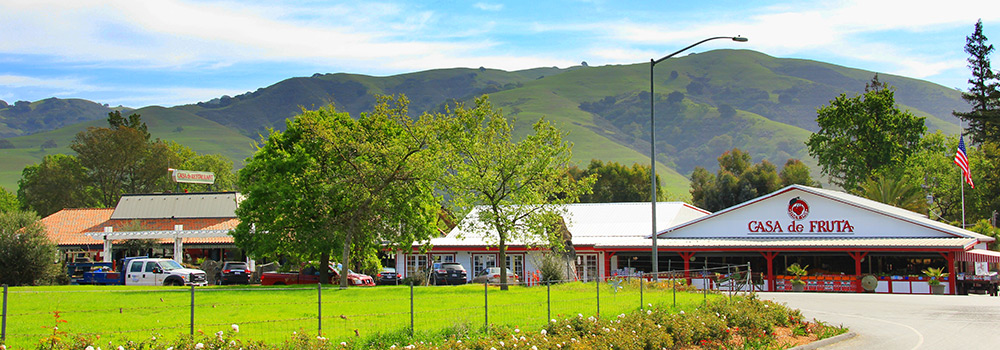
Spend the night in our cozy new Creekside Cabins, Casa de Inn, or RV Park

Taste our locally-produced red, white, sparkling, and specialty fruit wines

Stock up on farm-fresh produce, nuts, dried fruits, and gourmet gifts

Kids love the Casa de Choo Choo train, vintage Carousel, and Miner's Sluice

Fuel up for your road trip with delicious breakfast, lunch and dinner
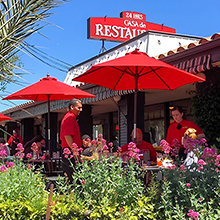
Visit Casa de Sweets for homemade candy, fudge, caramel apples and more
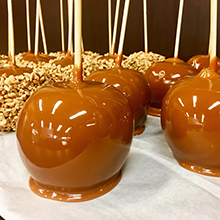
ONLINE STORE

Gourmet gift baskets, trays and crates to make any occasion extra-special

Taffy, fudge, and chocolate-covered fruits to satisfy your sweet tooth

Our world-famous apricots, cherries, and other delectable dried fruits

Sweet or spicy almonds, cashews, pistachios, walnuts, pecans and more
Visit Casa De Fruta
- Visit Casa de Fruta
- Casa de Fruta
Our Services
- Shipping & Returns
- Online RV/Inn Reservations
- My Wishlist
- Track My Order


Your Worldwide Travel Partner
Business travel with a human touch.
Customized solutions for your business needs and corporate culture.
We've Been Where You Want to Go
We craft unforgettable travel experiences for discerning travelers. Think of us as matchmakers for you and an unforgettable trip. We’ve been where you want to go.
Tailored travel guided by experts and powered by technology
With our hands-on approach TravelStore’s world class consultants are personally invested in your satisfaction. We deliver better value and superior service for businesses and craft singular experiences for vacationers.
Personalized Service
One-to-one service designed to fit your needs and preferences, with around-the-clock support while you travel.
Technology-Driven
Easy-to-use tools to keep trip details at your fingertips and simplify your travel.
Insider Connections
We leverage our global network to provide preferred rates, upgrades, and experiences you won't find online.
Employee-Owned
Our travel consultants and support teams are personally invested in making all your travels seamless.

Stay connected with TravelStore news
Your e-mail address

OutletBound
- Outlet Malls
- Outlet Stores
- Hotels & Travel
- Shop Online
- Tips & News
Search form
You are here, santa clara, ca outlet malls.
Search outlet malls near Santa Clara, CA to find the best and most convenient outlet shopping in the area.
San Francisco Premium Outlets
Marina square shopping center, gilroy premium outlets, tracy outlets - closed, the promenade shops at orchard valley, american tin cannery, napa premium outlets, vacaville premium outlets, petaluma village premium outlets, folsom premium outlets, factory stores at the y - closed, pismo beach premium outlets, the legends at sparks marina, santa clara outlets.
Our Santa Clara outlet mall guide has all the outlet malls in and around Santa Clara, helping you find the most convenient outlet shopping based on your location and travel plans.
OutletBound has all the information you need about outlet malls near Santa Clara, including mall details, stores, deals, sales, offers, events, location, directions and more. There’s no better resource to plan your Santa Clara outlet shopping trip!

OutletBound Club members receive exclusive outlet discounts, coupons and sale alerts. We work with outlet malls, retailers, hotels and restaurants across the country to bring you the latest offers and deliver them right to your inbox. It's free to join. Sign up now!
You can unsubscribe at any time.
We keep your e-mail safe. Privacy policy.

The Almanac
Menlo Park, Atherton, Portola Valley, Woodside
Santa Clara Valley used to produce apricots. Today, these city-run orchards serve as relics of a bygone era
- Click to share on X (Opens in new window)
- Click to share on Facebook (Opens in new window)
- Click to print (Opens in new window)
- Click to email a link to a friend (Opens in new window)

My grandparents have lived in their house in the Los Altos Highlands neighborhood for over 50 years, built on an apricot orchard in what was then unincorporated Santa Clara County. My grandfather maintains various fruit trees, from pomegranate and grapefruit to plum. But his Blenheim apricot trees are the originals and most reminiscent of the Valley of Heart’s Delight, what Silicon Valley was known as due to its fertile soil and plentiful orchards.
The orange- and pink-tinged fuzzy fruits are mostly sweet with a hint of sour. They are tangy and juicy, dripping down your arm after a ripe first bite. But the fruit, which must be handpicked, is also fragile. Its harvest season is short, lasting only a few weeks starting anywhere from late May to early July.
“You can’t go into the store and buy what you eat right off the tree,” said Matthew Sutton, founder of Orchard Keepers, an organization that installs and maintains home orchards, hobby orchards and edible gardens throughout Santa Cruz and Santa Clara counties. “Apricots that are bought in-store are picked early and their sugars haven’t developed properly. Even if they soften on the counter at home, they’re not going to have that same syrupy, sugary sweetness as a sun-ripened fruit at its peak. It’s a treasure to be able to get a tree-ripened fruit at the right time.”

From the 1850s to the 1970s, Santa Clara Valley was the center of apricot production, dominated by family-owned orchards.
While Silicon Valley is no longer an agricultural epicenter, nearly 75% of the apricots grown in the United States still come from California, according to the Agricultural Marketing Resource Center. (Although the harvest was small this year due to a harsher winter that blew blossoms off the trees during their approximately two-week bloom.)
Today, the three city-owned heritage apricot orchards in Saratoga, Sunnyvale and Los Altos are remnants of a history that has been preserved despite challenges due to climate change and increased development in Silicon Valley.
A fruitful past
Robin Chapman, a journalist and author of three books, including “California Apricots: The Lost Apricots of Silicon Valley,” grew up on the site of a former apricot orchard off Covington Road in Los Altos. Although she worked in broadcast journalism around the country, she “always felt like a Californian,” returning to Los Altos in 2009 to take care of her parents. Following their deaths, she wrote about Silicon Valley history as a way to process her childhood and their deaths.
“I had new eyes and much love,” Chapman said. “I was reconciling life as a child with adult life and the beauties of California.”
View this post on Instagram A post shared by Mountain View Voice (@mvvoice)
Technology had passed agriculture in local impact in 1973, about when she left, Chapman said, a time when Ames Research Center and Lockheed Martin helped transform the area into Silicon Valley. In response to the changes and disappearance of most of the agriculture, Chapman’s book sought to investigate how the orchards flourished in Santa Clara Valley in the first place.
Stone fruit originally came from Japan and China. It later reached the Mediterranean region, which was surrounded by sea and bay, just like Santa Clara Valley, Chapman said. When Junipero Serra and other missionaries came to California, they brought Mediterranean fruit trees with them as vestiges of the lives they left behind. With the aid of irrigation techniques developed by North African countries, Chapman said, missionaries cared for the apricot trees they had brought over, and 1792 was the first year of a significant apricot crop in California. And during the Gold Rush, the growing population noticed the good weather and success of fruit in the neglected mission gardens and accelerated the development of the orchards.
“Great weather and soil were ingredients for an (apricot) industry, just like in technology, when innovators, entrepreneurs and ideas were ingredients for an industry, even if it was a different medium,” Chapman said.

The 1850s marked the start of 120 years of success for apricot orchards in Santa Clara Valley, spurred by smaller family-owned plots. As railroad production increased, orchardists were able to move produce quickly and establish the agricultural economy. Apricot production reached a peak of 160,000 tons annually from almost 24,000 farms and orchards in Santa Clara Valley, Chapman said. (By comparison, total U.S. apricot production was 41,740 tons in 2021.) In the 1920s, Santa Clara Valley grew 8 million fruit trees each spring.
Apricots grow on shallow-rooted trees in deep, sandy soil and require 850 hours a year at temperatures under 45 degrees, which is why the Central Valley is too hot for apricots, said Orchard Keepers founder Sutton. Blenheim apricots are ideal for drying but aren’t easily shipped because of their fragility.
Dried apricots were used in World War I and II as soldiers began to appreciate the fruit in their diet, Chapman said. The fruit was often picked by children and their schools, aware of the labor, delayed fall start dates as a result. “It was only when we grew up and moved away that we realized how exotic and how scarce these apricots were everywhere else we lived. How lucky we were to enjoy them in such abundance!” Chapman wrote in “California Apricots.”
Los Altos Heritage Orchard
The Los Altos Heritage Orchard is located just off San Antonio Road, a busy street that runs parallel to downtown. The fruit trees surround a civic center, and the location features the city’s library, city hall, history museum and historic house. In late July, the trees were barren following the harvest and the soil was brown and dry, but colorful ribbons adorning little trees swayed in the wind as part of a children’s activity for the Apricot STEM Fair.
“We invited kids to look around and see how there are the healthy green trees, but there are also some trees that didn’t make it through the winter. The wishing tree activity (where children write their wishes on ribbons and attach them to the tree) is something that comes to us from other cultures. It’s part of our multigenerational, multicultural approach…to find ways for the harvest to be inclusive and equitable,” said Jane Packard, a Los Altos Hills native and chair of the Los Altos History Museum’s Orchard Commons Committee. Packard is also on the advisory board of Green Foothills, a member of Living Classroom and the “garden granny” for Gardner Bullis Elementary School in Los Altos Hills.
The Los Altos Heritage Orchard is the oldest city-owned heritage orchard left in the area. It was planted in 1901 by J. Gilbert Smith and sold to the newly incorporated city of Los Altos in 1954. In a 1970 contract between the city and San Jose farmer Don Speciale, the city declared the orchard a protected historical landmark. On track for its organic certification, no herbicides or pesticides are used in the orchard. The land is around 10 acres, and apricots are sold across the street at the DeMartini Orchard store, (the city makes no money from their sale.)
But the health of the orchard has declined following droughts, overpopulation of ground squirrels and the death of longtime orchardist Phil Doetsch in December 2022. Members of the community want to revive the orchard with native plants and various other trees to address the harm to the soil from having a monoculture, or only one type of tree, for 120 years, Packard said.
Previously, the orchard was tilled with a tractor, but Packard envisions a new chapter of no–till for the orchard, in addition to soil building, water conservation and pollinators through drip irrigation, mulch, native plants between trees to bring fertile soil, and pollinator plants. The goal is to reimagine the orchard as a hybrid orchard and garden through advisory councils and a community network, Packard said, creating multigenerational and multicultural programs to enhance the community’s appreciation for the site.
Packard pointed out the parallels between her hopes for people of all ages to find beauty in the site and the variety of ages of the trees in the orchard itself, with the “grandmas” being about 50 to 60 years old in addition to the trees that were just planted in December, which will start to bear fruit three to five years later. It’s the start of a “fully productive orchard,” Packard said.
“That’s particularly important to me because I’m doing this for the next generation,” she said. “I had these beautiful experiences when I was a kid under the apricot tree, and I want to provide the opportunities for kids to find whatever it is that they love about the orchard.”
Saratoga Heritage Orchard
Saratoga’s 14-acre orchard is the largest remaining heritage orchard, and it grows apricots, prunes and cherries in a public park. None of its fruit is sold, according to city stipulation, but Saratoga residents can sign up for designated community harvest days, which currently happen around twice a week, or volunteer with Village Harvest to pick fruit that’s donated to local food banks. The Blossom Festival is another community orchard tradition that started in 1900, celebrating the blossoming trees after the drought annually until World War II. In 2013, Saratoga brought the festival back.

The land was originally owned by the Marion family and later sold to Walter Seagrave, who kept it thriving for three generations before his death. The Seagrave family sold the property to the city in 1974 to build a larger library on-site. The orchard has since been protected as historical property and a Saratoga landmark.
“Sometimes when you see a nice orchard that has lots of land you think you might take just a few acres here and there and pretty soon it’s gone,” said Annette Stransky, president of the Saratoga Historical Society. “But we’ve been able to protect it so far.”
Stransky moved to Saratoga in 1980 and worked in tech marketing after growing up on a peach orchard in Central California. She wanted to get involved in preserving the Saratoga orchard because “it’s such a great symbol of our agricultural past. It’s part of living history and it’s really important to remember your roots, no pun intended.”
Sutton’s Orchard Keepers has been maintaining the orchard since early 2020 and has transitioned the land from a conventional agricultural system that is more industrial to a regenerative approach.
“We’re treating the land and environment with equity,” Sutton said. “We’re only putting things in the orchard that will benefit its vitality. A regenerative approach is not just what we can take; it’s also what we can give back.”
Before Orchard Keepers began its maintenance, the soil was bare and non-organic materials like herbicides were used. Now, instead of bare soil, there is a year-round cover crop that feeds the soil, moisturizes it and prevents degradation due to the sun. Keeping the soil fertile is one of four pillars Sutton described in his care of the orchard, in addition to trees (making sure they are healthy, vital and grown); pest and disease (creating organic controls, especially for the prevalent gophers and oak root fungus); and fruit (supporting a high-quality crop that the community can enjoy). This year, thousands of pounds of fruit were harvested, but Sutton said that is only a tenth of the orchard’s potential for 40,000 pounds of fruit after the 500 young trees planted in 2020 mature and bear fruit.
“The fruit trees grow really well here, and the quality can’t be beaten,” Sutton said. “It’s been so cool to watch all of these families come through during community harvests and see the kids eat a fresh, perfectly ripe apricot right off the tree. Their faces light up because it’s unlike anything you’d ever get from a store.”
Sunnyvale Heritage Orchard
About 880 Blenheim apricot trees make up the 10-acre Sunnyvale Heritage Orchard, located next to the Heritage Park Museum. Before entering the orchard, the Orchard Heritage Park interpretive exhibit displays its history in colorful panels from 1875 to 1975 in a barn-like structure. Fruit, including the dried variety, is available at the orchard fruit stand just a few steps away.
Originally owned by the Vidovich family, the orchard is a reminder of the apricot industry’s zenith as the economic lifeblood of Santa Clara Valley, according to the exhibit. The orchard was then maintained by the Pavlina family until the 1970s, when the city purchased it to build a community center.

Farmer Charlie Olson, 88, has maintained the orchard’s fruit trees since 1977 through an agreement with the city of Sunnyvale, but the vote to preserve the orchard wasn’t until 1992, an initiative that began when current museum founder and director Laura Babcock was reminiscing about the valley and fast-disappearing orchards with friends. Babcock has a home orchard herself, with apricots, citrus, apples, plums and peaches that she maintains.
“It was a unique history that I wanted to become involved in,” said Babcock, who moved to a Sunnyvale with strawberry fields and flower farms growing big carnations in 1979. “Sunnyvale is a very well-run, caring city. We have multiplied the number of residents dramatically over the last 40-plus years with all of the high-tech companies and developments…It’s changed, but then most every place in America has.”
Olson maintains the orchard, which is zoned as a city park, using more old-fashioned techniques, Babcock said, which includes the use of pesticides and sprays and sprinklers that are on all day, with water provided by the city, for the soil. Noting the harm to the soil caused by only having one type of tree, Babcock hopes to diversify the range of trees to include plums, cherries, walnuts and pears, other bounties the area was known for.

The Heritage Park Museum also invites a couple of thousand third graders annually for a free two and a half hour field trip to live as it were the turn of the century, learning how to prime the pump for water, wash clothes on the washboard, hang it up to dry and play with homemade toys available at that time. But the students do not physically enter the orchard or learn as much about the trees’ processes.
“I hope in the long run, the orchard becomes a teaching tool where we’re able to have walking paths through it, historical artwork or benches so people can actually sit in the serene ambiance of an orchard,” Babcock said.
Where to find the orchards
In addition to the three city-owned heritage orchards, other privately owned apricot orchards are located around Silicon Valley, including Novakovich Orchard, Packard Foundation Orchard and Alta Mesa Memorial Park. Here is a list of remaining apricot orchards we’ve compiled:
Los Altos Heritage Orchard : The Los Altos Heritage Orchard is run by the city and historically preserved. They are in the process of hiring a new orchardist. The fruit is sold at DeMartini Orchard store across the street.
Address: 1 N. San Antonio Road, Los Altos.
Saratoga Heritage Orchard : The Saratoga Heritage Orchard is run by the city, maintained by Orchard Keepers and historically preserved. The apricots are not sold, but Saratoga residents can come to Community Harvest Days or volunteer to pick fruit to be donated with Village Harvest.
Address: 13650 Saratoga Ave., Saratoga.
Sunnyvale Heritage Orchard : The Sunnyvale Heritage Orchard is run by the city and historically preserved. It is maintained by 88-year-old Charlie Olson, who is a third-generation orchardist. The fruit is sold at a barn next to the orchard.
Address: 560 E. Remington Drive, Sunnyvale.
Novakovich Orchard : Family-owned Novakovich Orchard sells fruit on-site, and the family used to also maintain the Saratoga Heritage Orchard down the street.
Address: 14251 Fruitvale Ave., Saratoga.
Packard Orchard: The Packard Foundation Orchard is a privately owned 60-acre orchard in Los Altos Hills operated by the Lucile and David Packard foundation.
Address: 26580 Taaffe Road, Los Altos Hills.
Alta Mesa Memorial Park: Apricot trees surround the Alta Mesa Cemetery, where Steve Jobs, a famous apricot fan, is buried.
Address: 695 Arastradero Road, Palo Alto.
Most Popular

Leave a comment
You must be logged in to post a comment.
We've recently sent you an authentication link. Please, check your inbox!
Sign in with a password below, or sign in using your email .
Get a code sent to your email to sign in, or sign in using a password .
Enter the code you received via email to sign in, or sign in using a password .
Subscribe to our newsletters:
- Weekend Express
- Breaking News Email Alerts
- Peninsula Foodist
- The Six Fifty
- Local Scoop
- Editorial Features
Sign in with your email
Lost your password?
Try a different email
Send another code
Sign in with a password
Privacy Policy

For the Love of Apricots
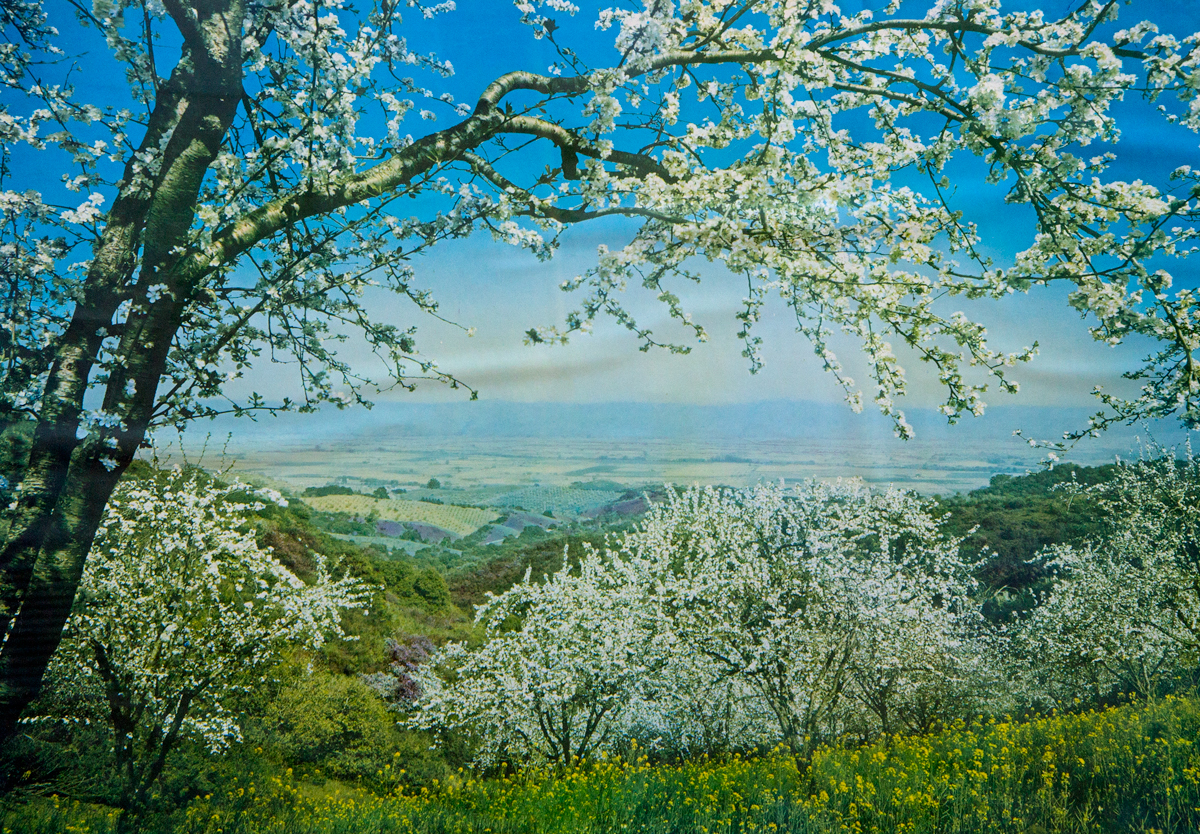
Valley of Heart’s Delight
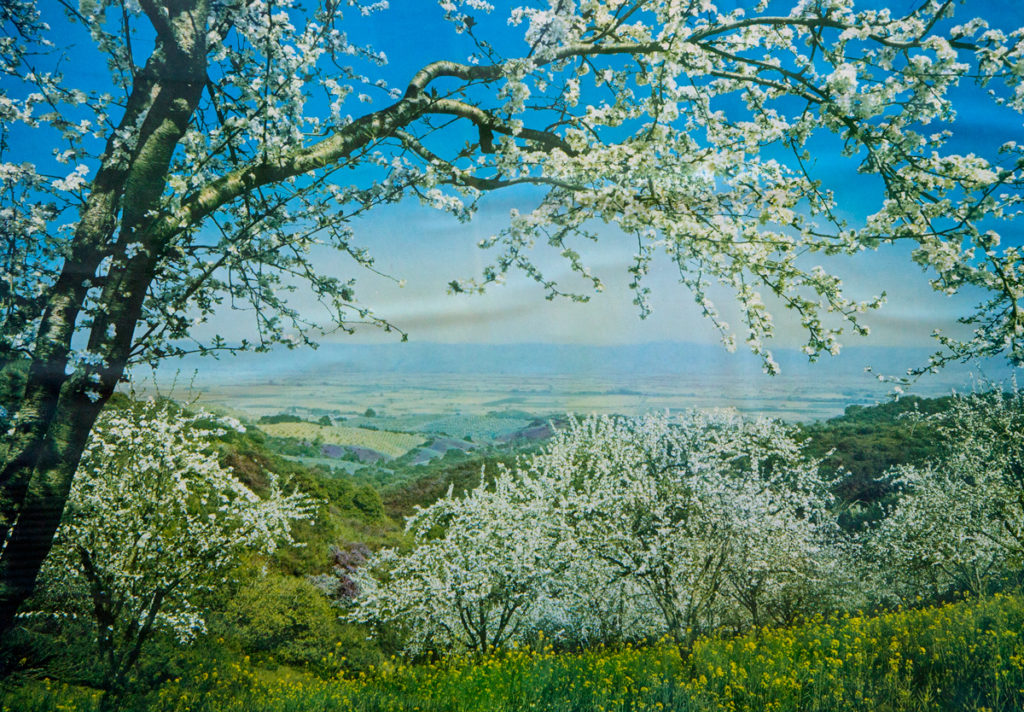
“The Valley of Heart’s Delight”

W hen I was growing up, Santa Clara County was still the foremost fruit-producing county in California with the romantic and well-deserved title, the “Valley of Heart’s Delight”. As children, we took for granted being able to wander among the great orchards in the spring, with their wealth of white and pink blossoms, and in the summer, when tree branches bent beneath the weight of purple prunes and golden apricots. The landscape was alive with color, sweet fruit, and fragrant smells.
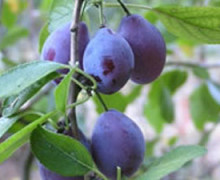
With a large remnant French Prune orchard, our Saratoga property also contained an arboretum of individual fruit trees: Apricot, Peach, Persimmon, Almond, Fig, Apple, Meyer lemon, Kumquat, and Loquat. Each one produced a tremendous amount of fruit, providing more than our family needed, which gave us kids a lazy summer pastime selling baskets of fruit along the road. Our Spanish style ranch house, built in the 1940s, was embraced by its orchard, fruit trees and gardens. I learned much later that our property was part of the original Glen Una Ranch , which was once the world’s largest French prune orchard.
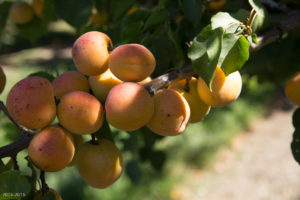
Many of my childhood friends earned money picking apricots and prunes in nearby orchards during the summer. They had to climb up into the trees to fill 5-gallon buckets, brushing aside bugs and bees. More of them got jobs cutting the “cots”, then setting them on wood trays that covered acres and acres of land to dry in the summer sun. They were paid by the tray and it was hot, messy work.
In that era, with just one or two apricot or prune trees in their own yard, it was common for families to improvise their own drying methods, even using their screen doors to dry the fruit to preserve and enjoy throughout the year. Orchardists sold very little fresh fruit and nearly the entire crop was dried or canned. Our world was circumscribed by fruit trees and orchards and we didn’t give much thought as to how it came to be that way.

Santa Clara Valley’s agricultural origins formed long before it gained its charming name, the “Valley of Heart’s Delight”, with the establishment of the Missions at Santa Clara and San Jose in the late 1700s. Eugene Sawyer describes this in his book about the History of Santa Clara County :
“ The fathers who planted the Missions, planted orchards at the same time and found a full return for their labor. The fertility of the soil was supplemented by a peculiarity of climate that enabled trees to grow many more weeks in the year than in other countries, while during the season of rest there was no freezing weather to chill their sap or delay their progress in the spring “.
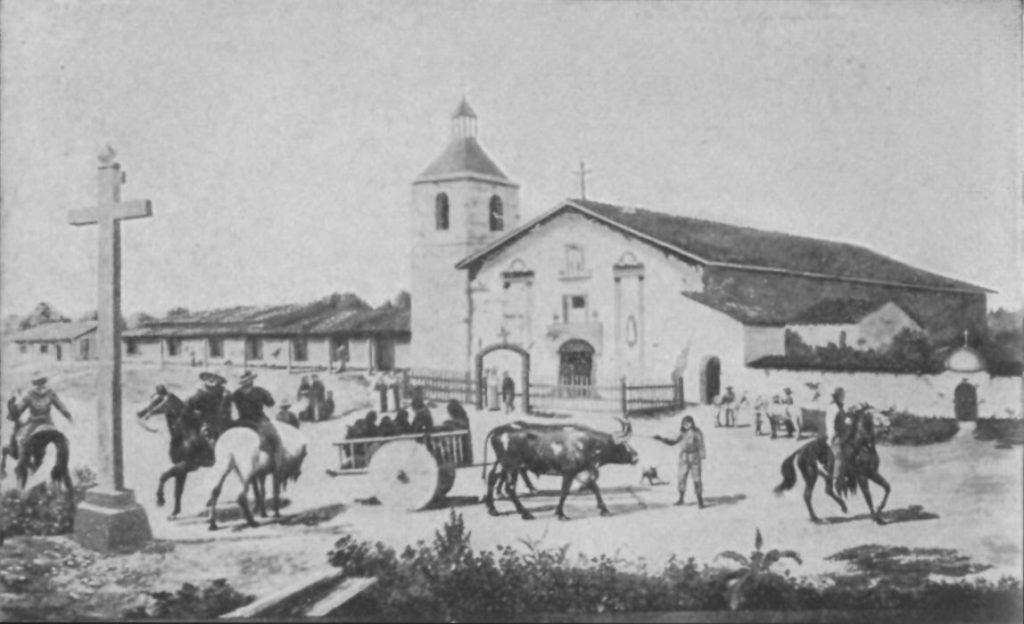
In the 1790s, explorer George Vancouver wrote of the Mission orchards, “ Here were planted peaches, apricots, apples, pears, figs and vines, all of which excepting the latter promised to succeed very well. ” As growth progressed in the early 1800s, it was incredibly important that they had access to the best ranch equipment on the market, as they played a big part in helping the Mission orchards to supply the early cattle ranches with fruit when the primary commerce was in horses, cattle, hides, tallow, and wheat.

The Gold Rush in 1849 brought the era of the American settlement to California, and for those who sought land rather than gold, the Mission orchards provided the first grafts for early orchards. H.S. Foote wrote:
“ The scarcity of fruit and consequent high prices gave a great stimulus to horticulture. Apples, imported into San Francisco, sold at retail for a dollar apiece, and other fruit in proportion. People thought that at half these prices there would be more money in a bearing orchard than in the richest gold mine yet discovered. “
The early orchards were primarily planted with pears and apples. One large step toward Santa Clara County becoming a worldwide producer of fruit was made by the Frenchman, Louis Pellier , who introduced “la Petite Prune d’Agen”, the French prune, in 1854. When grafted onto the local wild plum rootstock, he produced the famous Santa Clara Valley prune that became the predominant fruit in the county within a few decades. Louis and his brother Pierre also founded the Mirassou Winery. Because of the Pellier brothers, California produces 99% of the nation’s prunes and 70% of the world’s prunes.
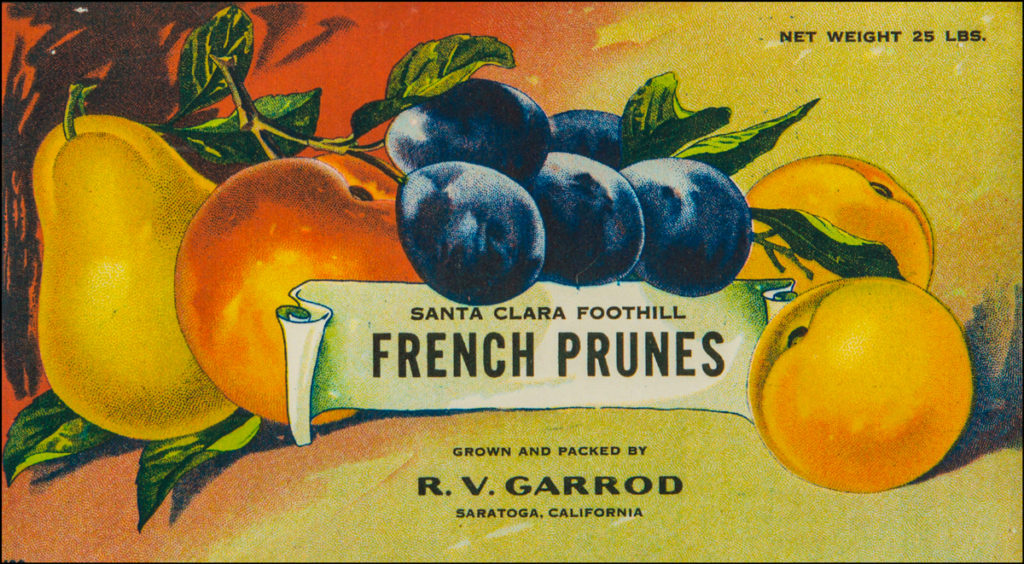
In 1868, the completion of the transcontinental railroad opened up markets for fruit transport to the East and stimulated the development of fruit processing and shipping in the valley. Janet Humphrey’s pamphlet about fruit preservation in Santa Clara County, From Blossoms to the World , notes that within a few years, Dr. James M. Dawson created the first commercial cannery, the San Jose Fruit Packing Company and soon after, canneries spread all over the valley. The more modest but still important invention of the Mason canning jar, in 1875, created greater convenience for home canning of fruit, preserves, and vegetables. As a result of these innovations, Eugene Sawyer noted:
“ The fruit industry grew by leaps and bounds, vineyards, pastures and grain lands were converted into fruit orchards until the county became one vast orchard — the largest in the world. “
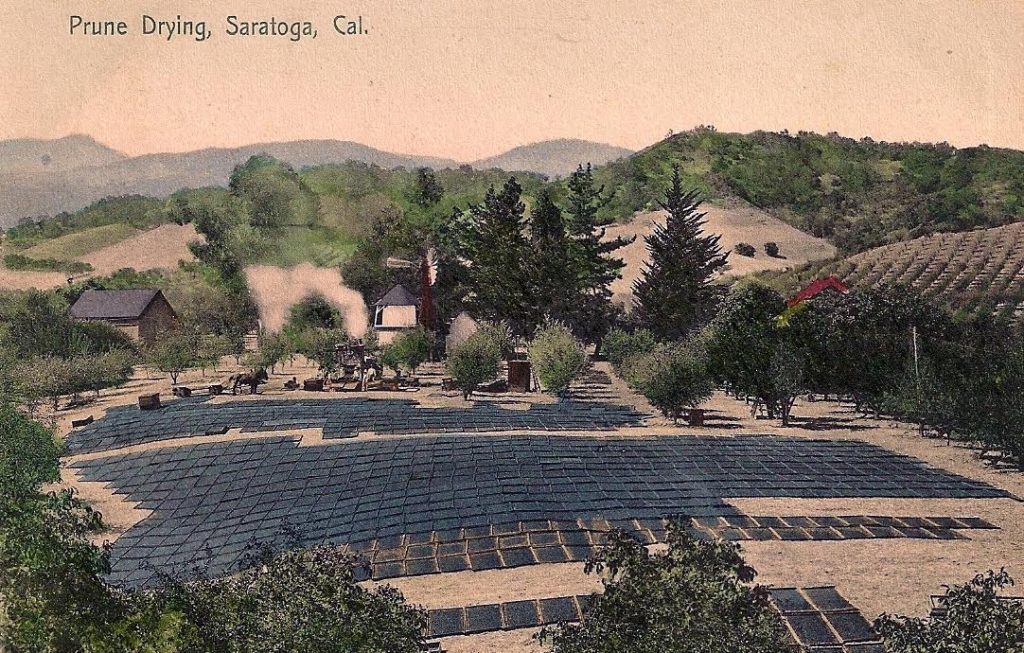
By the turn of the century, the orchards spread for miles up and down the County, as recounted by E. Alexander Powell , a world traveler, who wrote:
“ If you go to the Santa Clara Valley when I did, which was in March, you will find that the people of the valley are celebrating the Feast of the Blossoms. It is a very beautiful festival, in which every man, woman and child in this fifty-mile-long garden of fruit and flowers takes part, but you cannot appreciate its true significance until you have climbed to a point on the slopes of the mountains which form the garden wall, where the whole enchanting panorama lies before you. Did you ever see one hundred and twenty-five square miles of vineyard and trees in snow-white blossom at one time? “

The City of Saratoga initiated the Blossom Festival tradition in March, 1900, “to express thankfulness for the harvest to come, when the fruit trees of the valley were in bloom.” The first year, Saratoga families drove their horse buggies to the Los Gatos railroad depot to meet local visitors who arrived on the narrow gauge train, and took them on a ride through the Glen Una Ranch to view the blossom panorama; then on to the Village for games, prizes, and a picnic meal. Hundreds of people enjoyed the experience, far exceeding their expectations! The next year, over 2,000 visitors attended the Blossom Festival, traveling from across the Valley and as far away as San Francisco.

The strain of providing transport for the instantly popular event was solved in 1904 when the San Jose & Los Gatos Interurban Railway began service connecting San Jose, Campbell, Los Gatos, Saratoga and Mayfield (south Palo Alto), bringing Festival guests directly to the Village of Saratoga. The Festival quickly grew to have an international reputation and enjoyed crowds of up to 20,000 at its peak. With the growth of automobiles, transportation to the Blossom Festival became more individualized and people could tour on their own along a recommended route during the season. The Blossom Festival continued for 42 years, until WWII, when it was interrupted by the war. It was only recently revived in 2012.
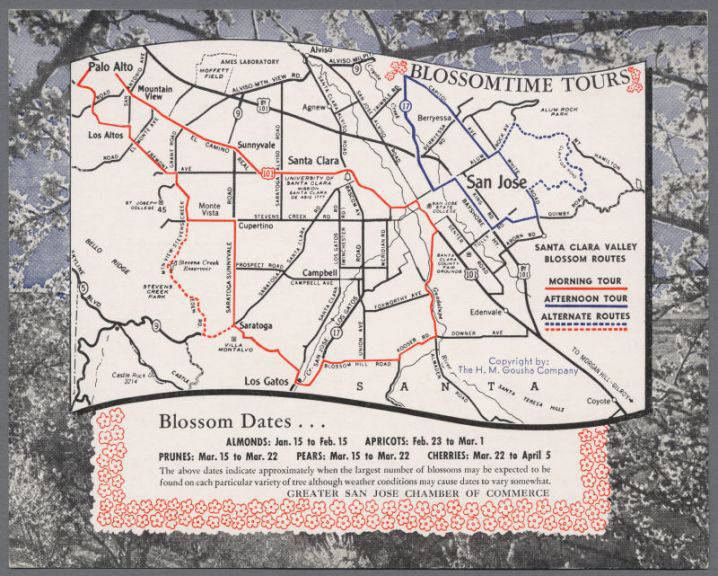
In 1914, just before the 1915 Panama Pacific Exposition brought even greater attention to San Francisco and the Bay Area, Santa Clara County and its member cities’ Chambers of Commerce published a booklet extolling the virtues of this agricultural paradise.
“ This is the valley whose reputation is not Californian, not confined to the United States, but like its fruit and the scent of its blossoms has spread to far-away lands. World visitors come to glimpse its beauty, sip its nectar and breathe its perfume. “

Somewhere near the peak of its existence, in 1919, the Valley of Heart’s Delight comprised close to 100,000 acres planted in fruit trees and 3,000 acres in vines, nearly 25% of the total valley. Farmland cultivated with vegetables and berries covered another 86,000 acres. More prunes were grown in the Santa Clara Valley than were produced in the entire United States. In 1919, there were 7,652,000 prune trees. Apricots came next with 665,000 trees, peaches third with 482,000 trees, and cherries fourth with 380,000 trees. At that time, Santa Clara County’s production represented 75 percent of the prune and apricot acreage of the State.
By 1939, San Jose had a population of 57,651 and was the largest canning and dried-fruit packing center in the world, with 18 canneries, 13 dried-fruit packing houses, and 12 fresh-fruit and vegetable shipping firms. As Yvonne Jacobsen wrote in her expansive work about family farms in the Santa Clara Valley, Passing Farms: Enduring Values ,
“ The war changed everything. It brought thousands of military personnel to the West Coast on the way to the Pacific and helped speed the country’s westward movement of population. After the war, Santa Clara County led the state with an increase in population at a rate double the growth of California itself.”
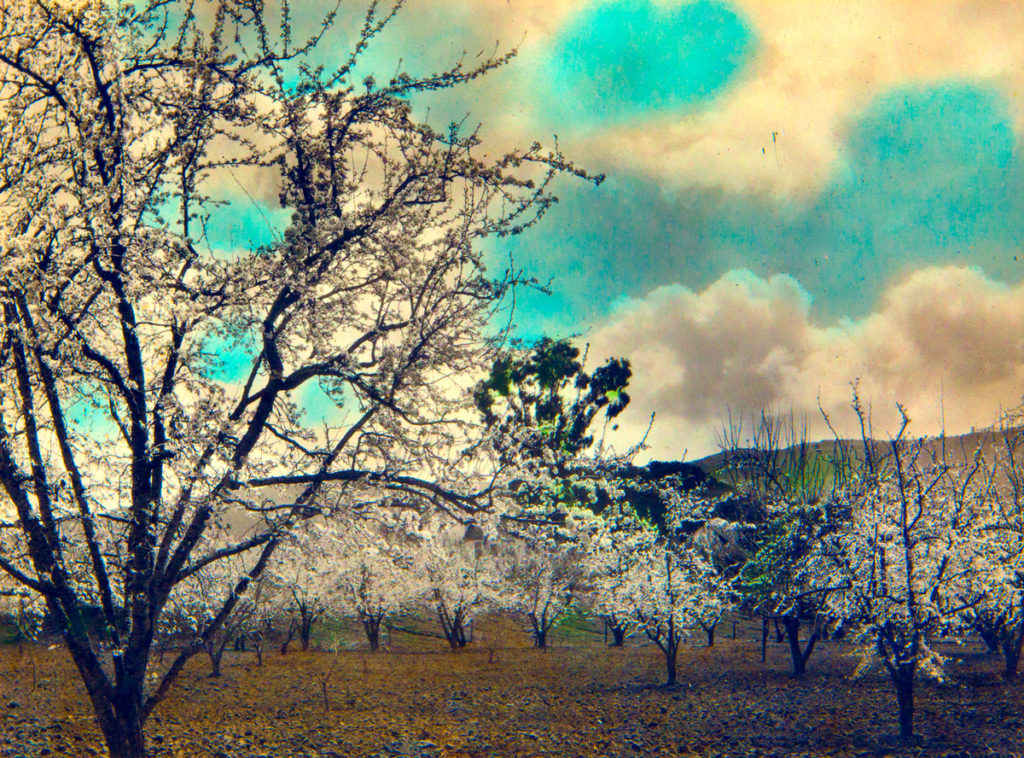
As is well documented in histories of the Valley, the end of WWII brought an era of rapid growth and investment in the region. The City of San Jose as well as small towns like Sunnyvale, Cupertino, and Campbell expanded over the flat, fertile land to accommodate new suburban housing and commercial development, displacing farms at a steadily increasing pace.
By the early 1960s, when my family arrived in the Santa Clara Valley, orchards began to disappear rapidly, replaced by neighborhoods and shopping centers that often bore their names. Our first home in San Jose’s Willow Glen neighborhood was in a new subdivision carved out of a walnut orchard, with great walnut trees remaining in our front and back yards. The pattern continues to this day; it has just moved further south.
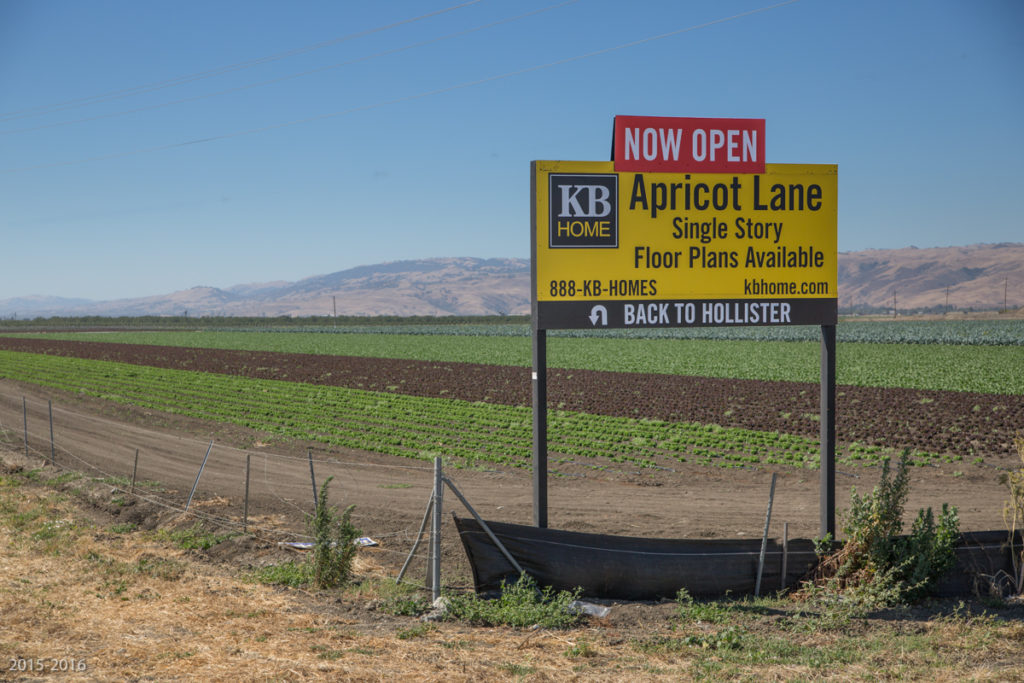
In 1984, author Wallace Stegner lamented the passing of the agricultural era, writing:
“ Silicon Valley is probably good. The Valley of Heart’s Delight was a glory. We should have found ways of keeping one from destroying the other. “
Fortunately, we still have the Apricot Orchard Families remaining today, striving to maintain the Valley of Heart’s Delight traditions of producing world-class fruit! I had the pleasure of participating in the Farm Tour and Tasting event at Andy’s Orchard on July 2. Hundreds of people arrived from all over the Bay Area to sample dozens of apricot varieties that Andy cultivates, along with a wide range of other stone fruits. In addition to the Royal Blenheim apricot, we especially enjoyed tasting the Bonny Royal, Candy Cot, Alameda-Hemskirke and Afghanistan varieties, while sharing tastes of the delicious Apricot Bar recipe that Andy gave me and information about the forthcoming For the Love of Apricots cookbook.
While apricots are still available this summer, I hope you will enjoy this simple, colorful and delicious tart as much as I do.

[recipe print=”true”]
Apricot-Strawberry Tart
This simple, elegant tart is adapted from “The American Baker” by Jim Dodge, a Bay Area pastry chef of renown. I had the pleasure of discovering Jim Dodge while he was pastry chef at the Stanford Court Hotel in San Francisco and am proud to have a signed first edition copy of his outstanding cookbook.
Follow my blog
Related posts:.
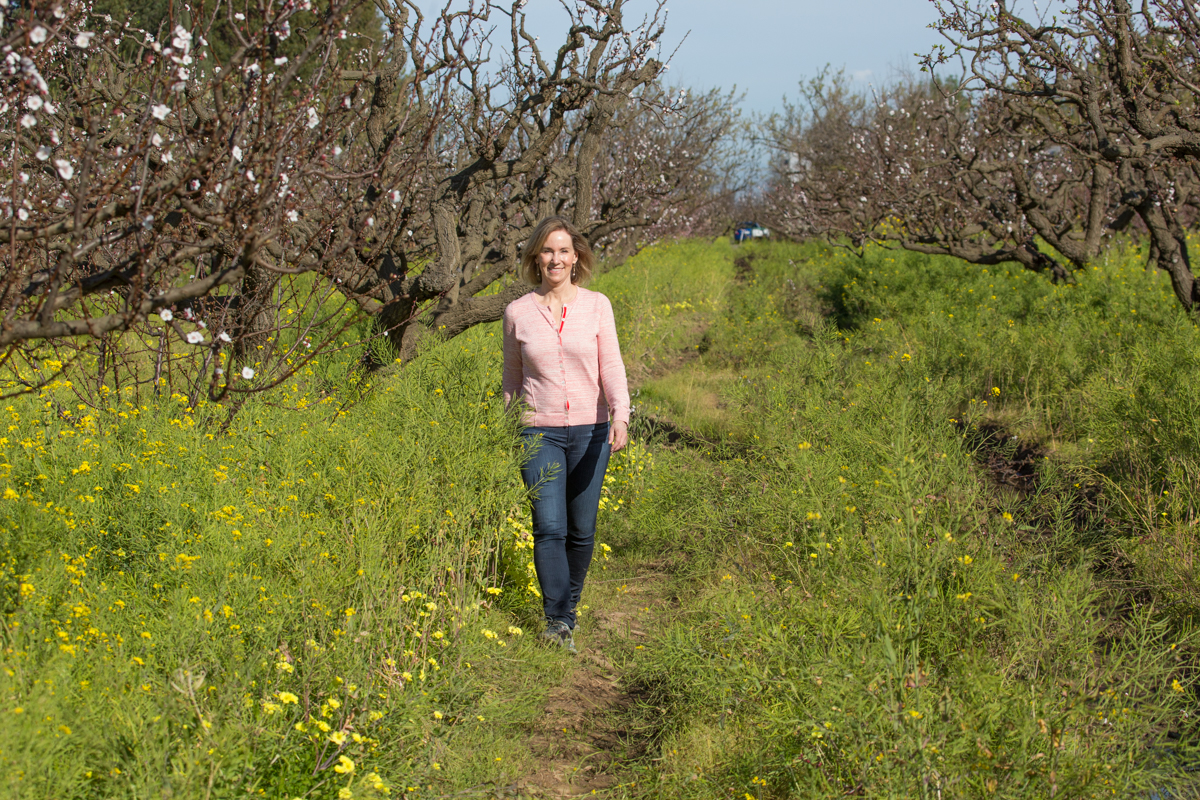
New Adventures in Apricots
I have loved apricots for as long as I can remember. They color my fondest memories of growing up in the Santa Clara Valley. As a child,…
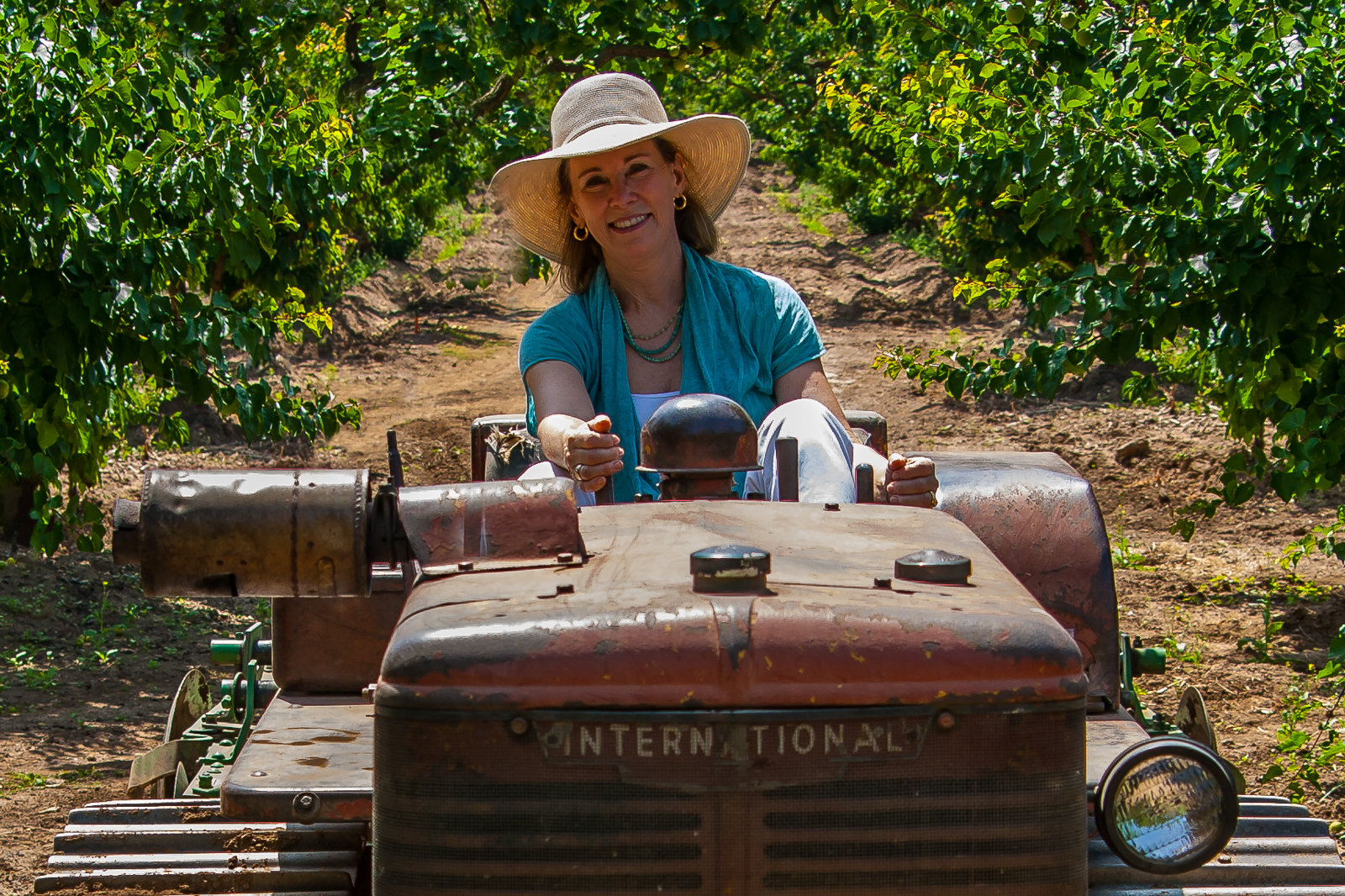
A Year in Apricots
2016 has come to an end, which brings the year-long experience of writing this blog to mind. I have truly enjoyed immersing myself and sharing experiences from a year-in-apricots.…
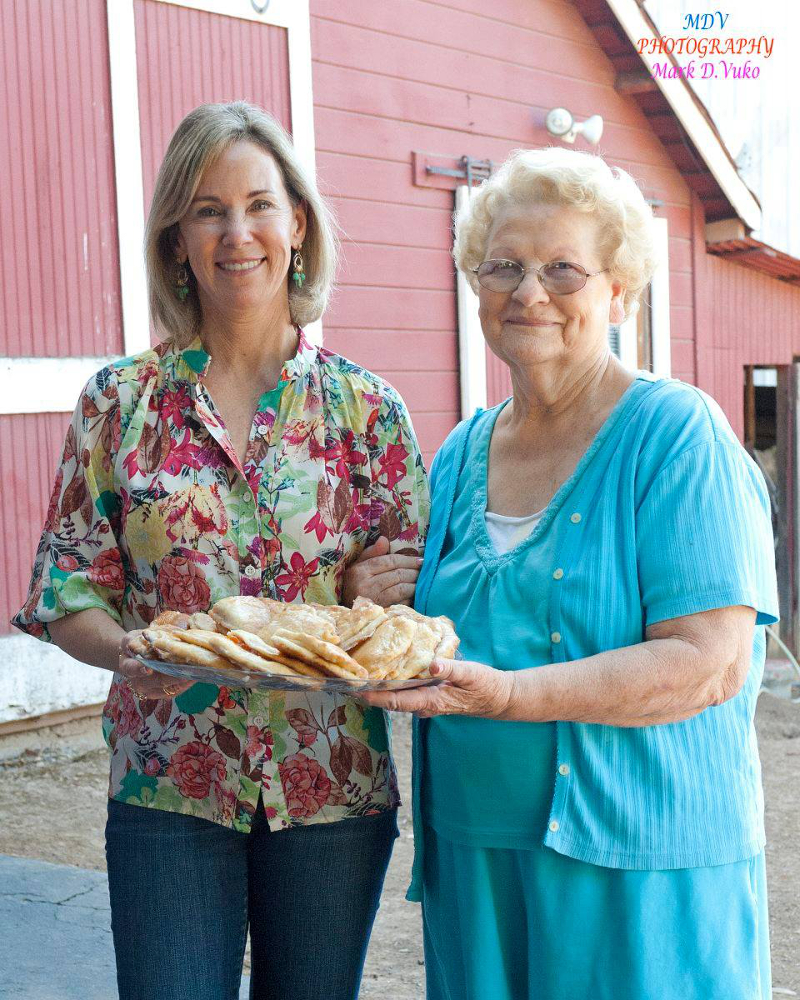
Fall Barbeque with Apricot Pies
One of the main ingredients that led me to the idea of creating a cookbook devoted to Apricots was my re-discovery of Novakovich Orchards in my home…
22 comments on “ Valley of Heart’s Delight ”:
- Pingback: California Homestead: California Apricot Harvest + Sorbet Recipe – Engaged Abroad
i grew up in Saratoga, CA. I remember all the orchards. so beautiful. I call the valley The Land of Mordor,now. does your book speak of migrant farm workers of the valley? thank you for preserving this formerly beautiful valley’s history.
I’ve lived in Campbell my entire life, and wrote a song about what it was like growing up here… “Cuttin’ Cots and Pickin’ Prunes” My parents settled here in 1949. My apricot jam won blue in the county fair, because our Blenheim apricots were so amazing. (A Minor) Daddy, born on the frozen prairie, Landed north west down by the sea. Wanderlust just captured his soul, Life of adventure became his goal.
Arizona called his name And things were never the same. A Kingman girl, oh so fine, A hidden gem down at the mine.
Just seventeen, he captured her heart Swept her away, a brand new start. California, paved with gold Packin’ their bags, they were sold. (BRIDGE to A Maj) To the Valley of Heart’s Delight, Their new home, oh so right. Life was simple then, all things right. Oh, so right, Heart’s Delight.
Chorus: Growin’ up in a carefree world, A fifties child in a family, Workin’ hard, summer afternoons Cuttin’ cots and pickin’ prunes, Cuttin’ cots and pickin’ prunes.
Before they knew it, children three, Brother, sisters, family. Growing, Scouting, twirling, whee, Kids on bikes, we were so free.
Cuttin’ cots, a quarter a tray, Back then, it went a long way. Bubble in time, perfect day But that was then, not today.
Back to A minor Seasons passed, the children grew, Subdivisions made orchards few. Shopping malls, not county fairs. The simple life, no longer theirs, Cuttin’ cots and pickin’ prunes, Cuttin’ cots and pickin’ prunes.
©Rhonda Janes Bump, 2014
Is Heart’s Delight Apricot nectar still available? I loved it as a child.
Enjoyed reading your blog. My family settled in the Santa Clara valley in the early 1900s. Lots of memories surfaced while reading. Thank you for all the effort you put into this.
I grew up on the east side of this beautiful valley in the foothills of Mount Hamilton. Our view stretched from Evergreen to Moffett Field, and the valley I recollect from childhood was a patchwork of orchards with very few lights after dark. Today it looks like Los Angeles at night (aka Silicon Valley), with thousands of twinkling lights. I remember playing in the tall green grass and mustard flowers every spring after the rains. But most of all I remember summer, when we ran wild in the hills and ate our fill of apricots and plums. At one point every summer my Sicilian godmother would turn up our steep driveway to deliver a groaning load of apricots. Then I knew I’d have to stay indoors helping my mom make jam for a day or two. The reward was always fresh apricot cobbler, my favorite dessert to this very day. Thank you Lisa, for making these memories come alive again! I love the way we share memories of the same valley from east to west.
My grandparents, coming from Sicily and trying to save up money working in SF, bought land here after the 1906 earthquake destroyed their home. We had one hundred ten acres of apricots off Quimby and Aborn in Evergreen. It was wonderful to look down on the valley that seemed to be painted white in the spring. That was sold and became part of suburbia. We moved to Morgan Hill and grew prunes. Those were the days when agriculture ruled everyone’s schedules, provided a living, and fostered a sense of community. I miss the abundance of birds and insects, I miss the beautiful uninterrupted pastoral scenes, and I feel sorry for the workers stuck in cubicles and for kids who can’t walk home from school through mounds of blossoms and pretend they are kicking snow.
The world is very small and while I sit in this beautiful area of paradise, I know little of the history of my chosen part of Paradise. I grew up in Savannah Ga, moved to the North east as a bride and found CALIFORNIA in the early 70s. I thoroughly enjoyed this beautifully written information and the photos. And I received it this morning in my email from a friend who lives in Pakistan who became our close friend when he spent two years living in the Bay Area. Thus the “small world” comment. I do visit the Apricot orchard(located on Fruit dale Ave in SARATOGA) at least twice a year and the drying season is a wonderful experience with hundreds of cut apricots drying on racks,as seen in your photo, producing a beautiful sea of orange colored fruit. These drying fruits are then sold by the orchard in many forms, the best being the “turtles” which are apricots , covered in caramel and dipped in chocolate . Pure decadence. Thank for educating me with this historical article !!
Both of my parent’s families were prune and apricot growers in San Jose, Los Gatos, Campbell, and Evergreen. We continued the tradition of growing fruit until the late 1980’s. I always loved walking through the orchards and being involved when the crops came in. We take great pride in Our Valley and how it has evolved. Your Pictures and commentaries were “spot on”. I really enjoyed reading them and remembering that time in the Valley. Yes, I cut cots, picked cots, picked prunes, and canned fruit. Life was good!
Thank you Lisa for the memories. Mary Ann Sorci Crannell
Wow – I am the program chairman of a Womens Club in Cupertino and am planning our programs for our upcoming year. Our founding members were orchardists in Cupertino – and our Ladies would LOVE it if you could do a presentation for us. Can you please let me know if you could do this for us? Please respond to my email… Thank you
Wonderful post, Lisa! I messaged you on facebook about two more Saratoga families you might like to talk to.
Continued wonderful information. I am though saddened that the farmer is underestimated in this modern world. Real food, for a real life. Good blog. Thank you Lisa.
My Grandparents place was on Crossman Avenue in Sunnyvale, they had a pear orchard and one of great Aunts and Uncles had a prune orchard in the Morgan Hill area. My wife’s family had apples in the Watsonville.
Great blog and rich in history. My family is rooted in this valley; apricots and cherries. Our family has watched the demise of the orchards as they make way for high density housing and mass transit. We still grow our own and enjoy the fruits of our labor.
I grew up above Foothill College in Los Altos Hills. In 1967 I picked apricots as my 1st job. We got .25 cents per giant milk bucket. The orchard was next to St. Nichols school on El Monte. The boys picked and girls sliced them for trays drying. Hours were 7am-noon for 2 weeks. Sam Rado was our foreman and he constantly said; “Pick fruit!” And, “No bottom-picking!”
Growing up during the ’40s and ’50s in Saratoga was wonderful. I started picking prunes at the age of 6 in our family orchards at Fruitvale and Saratoga-Los Gatos Rd. Life was good.
Thank you so much for the history of the valley. My family has been in Santa Clara County since 1904, my boys are 4th generation born in the county. My mom often tells stories growing up and cutting cots during the summers. My grandmother worked the canneries in the summertime. So much history that a lot don’t know now that it’s Silicon Valley. Beautiful work and pictures!
You have exquisitely chronicled my family’s history. My great-grandfather purchased our small “Valley of Heart’s Delight” ranch in 1901. We had a walnut-and-pear orchard, plus apricot and peach trees for the family, and the neighbor across the road had a prune ranch (we traded fruit). My great-grandfather and great uncle crafted and sold wooden orchard ladders. Indeed, my summers were spent “cutting cots,” canning fruit and picking walnuts before school began (always started school with walnut-stained hands). In spring we took Sunday drives to view the blossoms.
Thank you so much for this beautiful piece and for the memories it evokes. Wallace Stegner nailed it.
As a child in the 50s and 60s, I thought Cupertino was heaven. I assumed I would live there forever (heck, my Dad was born there in 1922!), but by 1985, my family and I were gone. Up into the foothills of the Sierra Nevada…and we all do everything we can to avoid returning, even for a quick visit.
GREAT WORK! I really love all the classic photos and art you included in this blog, and especially how it concludes with the apricot-strawberry tart recipe. ? ? ? !!! 🙂
Love the pictures. I remember this valley looking like that! Having ancestors who came to the Santa Clara Valley long ago, we lived this life! My great-grandfather settled in Morgan Hill in the early 1900’s, coming from North Dakota to ‘walk’ the amount of property he wanted. He had prunes and apricots near what is now the corner of Wright and Hale in Morgan Hill. For years his drying yard had nothing on it, but now it’s covered with homes.
An uncle settled in Paradise Valley near Morgan Hill and I can still remember him telling me of the 1906 earthquake and how he was out in his orchard that morning and when the earthquake hit, he fell ‘over one of the ripples in the ground’ and watched his trees almost leap out of the ground.
Growing up the Morgan Hill in the 1960’s, we still had orchards and I remember cutting cots and picking prunes every summer. Even the school district went by the farmers schedules, and didn’t begin in the fall until the walnuts had been picked. Children were expected to help their parents get the harvest in.
An idyllic childhood, in the Valley of Hearts Delight.
Goodness, what a beautiful description of the valley and its evolution. Can’t wait to try the recipe!
Comments are closed.
Where to Find the Best Blooming Almond Orchards in California
Hundreds of leafless trees enveloped in white flowery veils get replaced by spectacular floral “snow” that covers the ground underneath them a few weeks later… Blooming almond orchards in California put on a show that you don’t want to miss.
Last updated: February 25, 2024

The 6 Best Places to Find Blooming Almond Orchards in California
We were driving from Big Sur back to Los Angeles, when all of a sudden decided to stop in Fresno for a night. Our road trip was almost over. Only 3-hour drive separated us from our home. Therefore, the last day of the journey was rather slow.
Although exploring Fresno wasn’t on our itinerary, we didn’t rushed to leave the city the following day. After a brunch at an Asian restaurant, our small party was finally ready to hit the road again. Yet after saying our farewell to Fresno, we stopped just a few minutes outside of the city. This time, endless blooming almond orchards that seemed to occupy entire Central California caught our attention.
The blossoming trees spread for miles on end, completely transforming the surroundings. Festooned with tiny, snow-white petals, the blooming almond orchards made California look festive. The Golden State had never looked so pretty even in preparation for the Fourth of July.
The blossoming almond orchards prolonged the last day of our road-trip through Central and Northern California . We didn’t mind it at all. What surprised us the most was the absence of other cars. The blooming almond orchards is a remarkable sight that the majority of Californians wait for all year long. Nevertheless, unlike colorful flower fields that usually adorn state’s rolling hills a few weeks later, the orchards normally don’t gather the largest crowds.
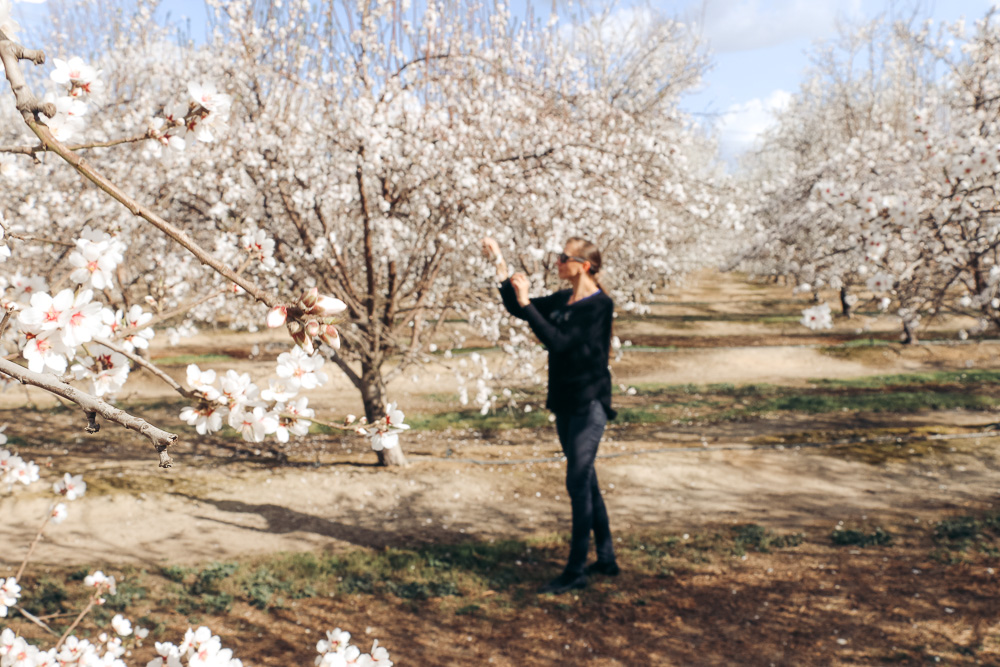
Interesting Facts about Almond Orchards in California
Family-owned enterprises.
The fact that nearly 90 percent of the almond orchards in California are family owned keeps the crowds away. Driving past the blossoming trees, you notice metal wires that separate the orchards from the public land. Some places in California might even have signs, confirming that the almond orchards are indeed the private properties.
Traditions Passed from Generation to Generation
Interestingly enough, some of these almond orchards has adorned Central and a part of Northern California for at least half a century. Overall, the production of the favorite nuts in the Golden State dates back to the early 20th century. Starting from scratch, learning new techniques, and developing the land, the first owners of these tree plantations now pass their knowledge and agricultural traditions to new generations.
Take Fresno as an example. The majority of the locals and visitors of California delight in the astounding views and gentle aroma of the blooming almond orchards near the city. Yet only a few know that the famous Fresno County Blossom Trail has been impressing its oblivious guests for more than 30 years now.
California Has Ideal Weather for Growing Almond Orchards
Cool, wet winters followed by warm, hot summers – it’s the typical weather in Central California. And it’s all what the nut trees need. The almond orchards thrive in this environment, enriching California with the locally-grown favorite nuts and mesmerizing blooming seasons.
California is the Largest Producer of Almonds
The distinctive weather of Central and a part of Northern California allows for planting and growing a myriad or almond orchards. In fact, the Golden State produces more than 80 percent of the world’s almonds .
Different Uses of California’s Almonds
California produces different varieties of nuts. One almond orchards can grow the trees that produce large nuts, popular as snacks, as well as small nutty fruits that are used as fillings for candies and chocolate bars.
Nuts are main ingredients of many different almond products , ranging from milk to butter and flour. Even meat substitute companies rely on these popular California-grown products as healthier alternatives to soy meats.
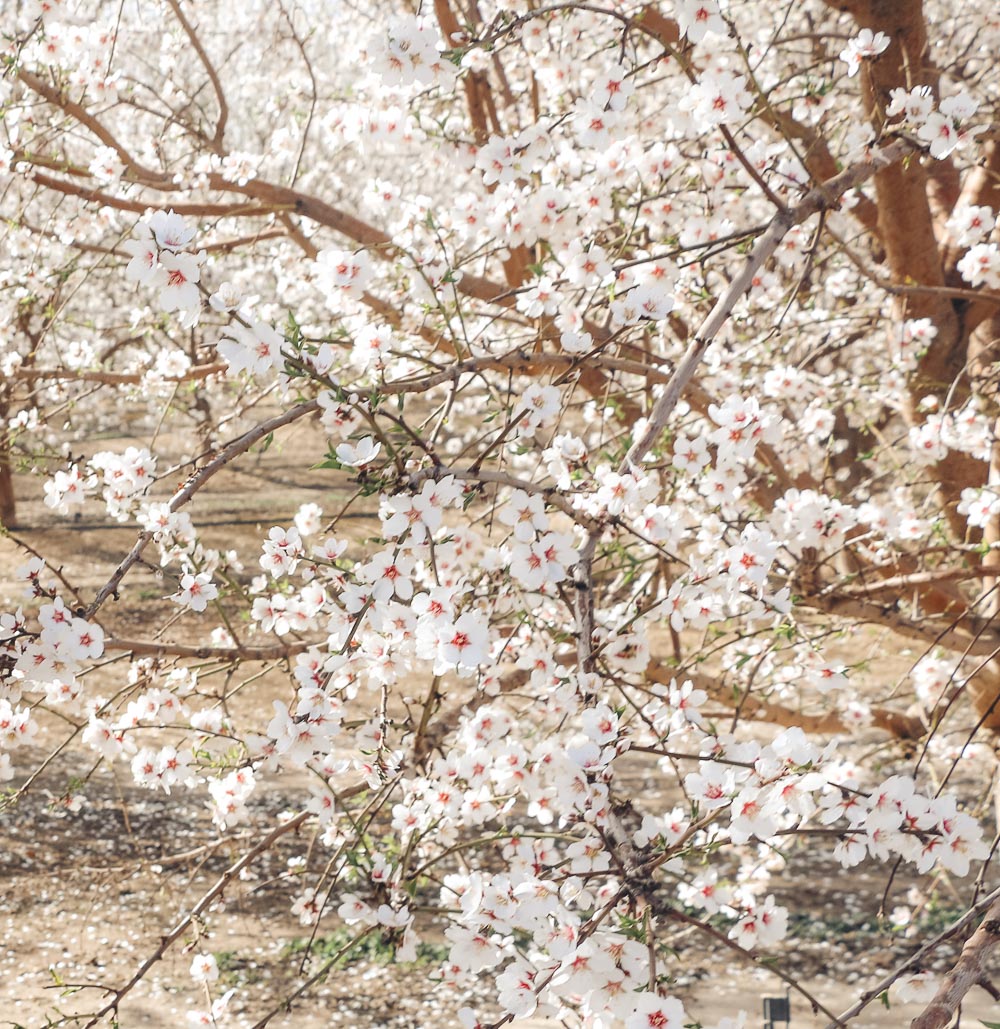
Are There Only Almond Orchards in California?
Many visitors instantly take the snow-white petals on the trees covering extended fields of Central California for almond orchards. Indeed, the white bloom is one of the characteristics of the almond trees. Yet California has more than just almond orchards. The white flowers also adorn apple, plum, apricot, and citrus trees, making them look almost identical to the untrained eye.
The colors of peach and nectarine blossoms differ from the rest, adding pink and red hues to the flowery idyll. These blooming plantations, however, look as stunning as the famous almond orchards in Central California. Similarly, they are short-lived. After blooming for a few weeks, almost all orchards in California, including almond, shed their decors.
The Best Time to See Blooming Almond Orchards in California
The almond orchards in California are in bloom now. Every year from mid-February until mid-March, thousand of he blossoming trees morph the Central Valley of California into a white floral sea. The bloom, however, doesn’t last long. The almond trees keep their flowery accessories for approximately three weeks before covering the ground with the beautiful spring “snow”.
Tips for Photographing Almond Orchards in California
The almost surreal white ocean of the blooming trees is a sight to behold. Amateurs along with professional photographers flock to the central region of the Golden State to capture this flowery veil while it lasts.
I certainly couldn’t pass by the blooming almond orchards of California without snapping a few shots. Sadly, I made a few mistakes while photographing this flowery opulence. Learning is growing, though. So here are a few tips you might want to use while shooting the almond orchards in Central California.
- Shoot at sunrise or sunset . Soft sun rays create an almost dreamy environment of the already astounding scene. On top of that, in the morning, the sun is low enough to avoid long shadows that you will see a lot while shooting the blooming almond orchards in the afternoon.
- Search for places where rows of trees are close to each other . This tightness fills the frame, adding details and instantly improving the image.
- Aim for areas with grass under the trees . Similarly, the grass under the almond trees adds some colors and fills the frame. The barren land between the almond trees diverts the attention, diminishing the overall effect.
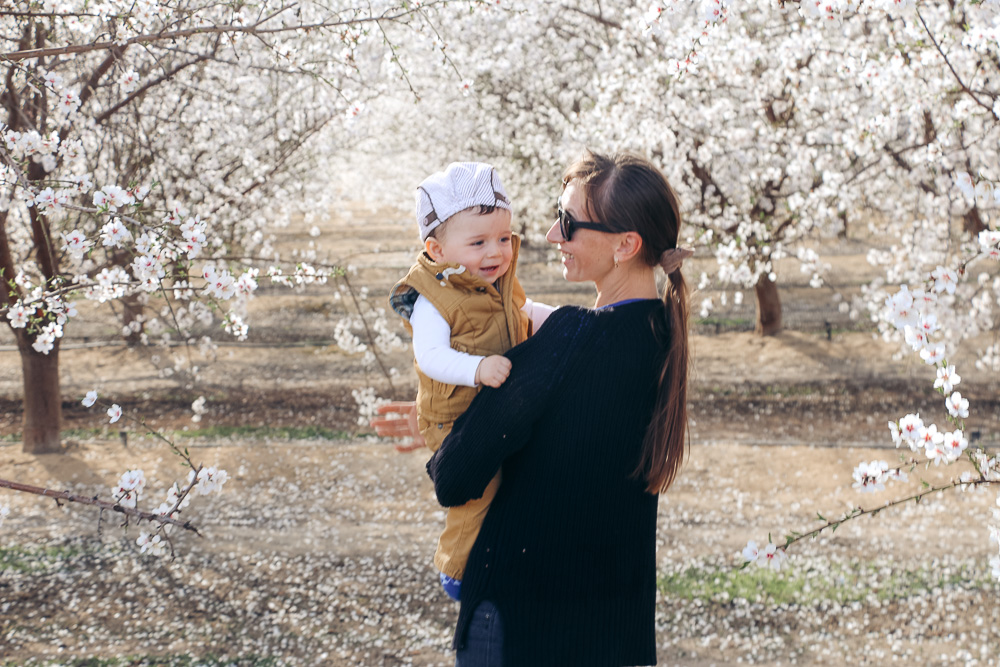
WHERE TO FIND THE BEST BLOOMING ALMOND ORCHARDS IN CALIFORNIA
The almond orchards grow mostly in Northern California, between Dixon and Woodland, just outside Sacramento . In central parts of the state, they cluster near Fresno. You can drive around and find the blooming orchards on your own. For those who need some specific directions, I’ve compiled the list of the best places, including farms, where you can find the most enchanting almond orchards in California.

1. Almond Orchards in Dixon, California
Dixon is a small town in northern Solano County in Northern California with population of a little bit over 20,000. Known for its Gold Rush days, the origins of the town date back to 1852 when gold hunter Elijah S. Silvey established the first settlement. The place kept attracting more people. A few years later, a large community already occupied the area, and construction of railroad was underway.
Originally, the town was named “Dicksvile” after Thomas Dickson who donated a 10-acre parcel of his land for building the railroad depot. When the first rail shipment arrived, though, it was mistakenly addressed to “Dixon” . The name stuck and has been used ever since.
While the gold in California eventually dried up, agriculture has always been one the main sources of income. Dixon isn’t an exception. Having some of the most fertile soils in the area, it allows the farmers to grow everything from nuts to fruits and vegetables. The blooming almond orchards are also a familiar sight in this region of California. Here are a few farms where you can find the blossoming trees near Dixon.
Where to Find Blooming Almond Orchards in Dixon, California
- Nut-N-Other Farms
- Rotteveel Orchards
2. Almond Orchards in Woodland, California
Woodland, one of the closest neighbors of Dixon, is also responsible for adorning Northern California with an array of blossoming orchards. This fairly big city with population over 50,000 sits in Yolo County, 15 miles northeast of Sacramento.
Woodland was established in the 1850s and still preserves that laid-back lifestyle and historic buildings spared by time and modern traditions. Trees, including almond orchards, dominate this region of California. Therefore, it doesn’t come as a surprise that the locals refer to Woodland as the “City of Trees”.
Where to Find Blooming Almond Orchards in Woodland, California
- Almond Lane . Almond Lane, a family-owned almond farm, has provided California with the organic nuts since 1953. Its agricultural traditions date back to the early 1900s. ( Note: As of October 2023, the farm is temporarily closed.)
- Blooming orchards along Highway 16, just outside Woodland
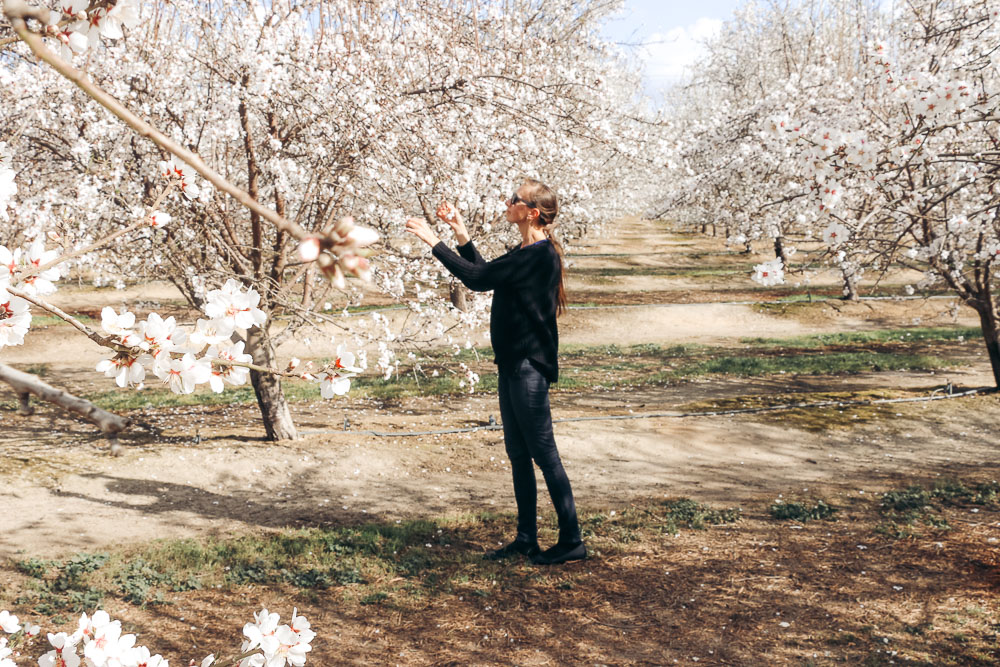
3. Almond and Other Orchards in Fresno, California
Fresno is a big city in the California’s San Joaquin Valley, the southern portion of the California’s Central Valley. Founded in 1872 as a railway station of the Central Pacific Railroad, it was incorporated in 1885. Today, it has more than 500,000 residents and is known as a primary spot for agriculture.
Fresno means “ ash tree ” in Spanish. The name certainly suits the city, which area is dotted with farms and orchards. Apart from the almonds, the region is famous for the production of local raisins.
Where to Find Blooming Almond Orchards in Fresno, California
Fresno county blossom trail .
Encompassing several orchards and vineyards, the Fresno County Blossom Trail is the best place to find the blossoming almond, apple, citrus, plum, and other trees. While the white petals indicate on the presence of the almond orchards, the pink and rose shades festoon peach, nectarine, and sometimes apricot plantations.
The spring-infused 62-mile loop sits southeast of Fresno and neighbors the Orange Blossom Trail with its white-flowered blossoming lemon and orange groves. Blossom Trail Cafe , located nearby, brings the freshest produce from the orchards to the tables of its guests.
From May to September, this same route transforms into the Fresno County Fruit Trail , abound with fresh nuts and fruits.
4. Almond Orchards in Escalon, California
The Central Valley provides California with a myriad of places to feast your eyes on the blossoming almond orchards. After Fresno, Escalon, a city with less than 10,000 residents, amazes with its blooming fruit and nut trees at the beginning of the spring season. The word Escalon comes from Danish and means “ stepping stones ”.
The city takes its beginnings in the late 1800s when James Wheeler Jones settled in the area with his family. While James had little to do with the establishment of the community, his son John Wheeler Jones was credited as one of the main founders of the town. Escalon has been a leading agricultural community since the time of its creation.
Where to Find Blooming Almond Orchards in Escalon, California
- Veenstra Farms Almond Orchard
- Roche Brothers
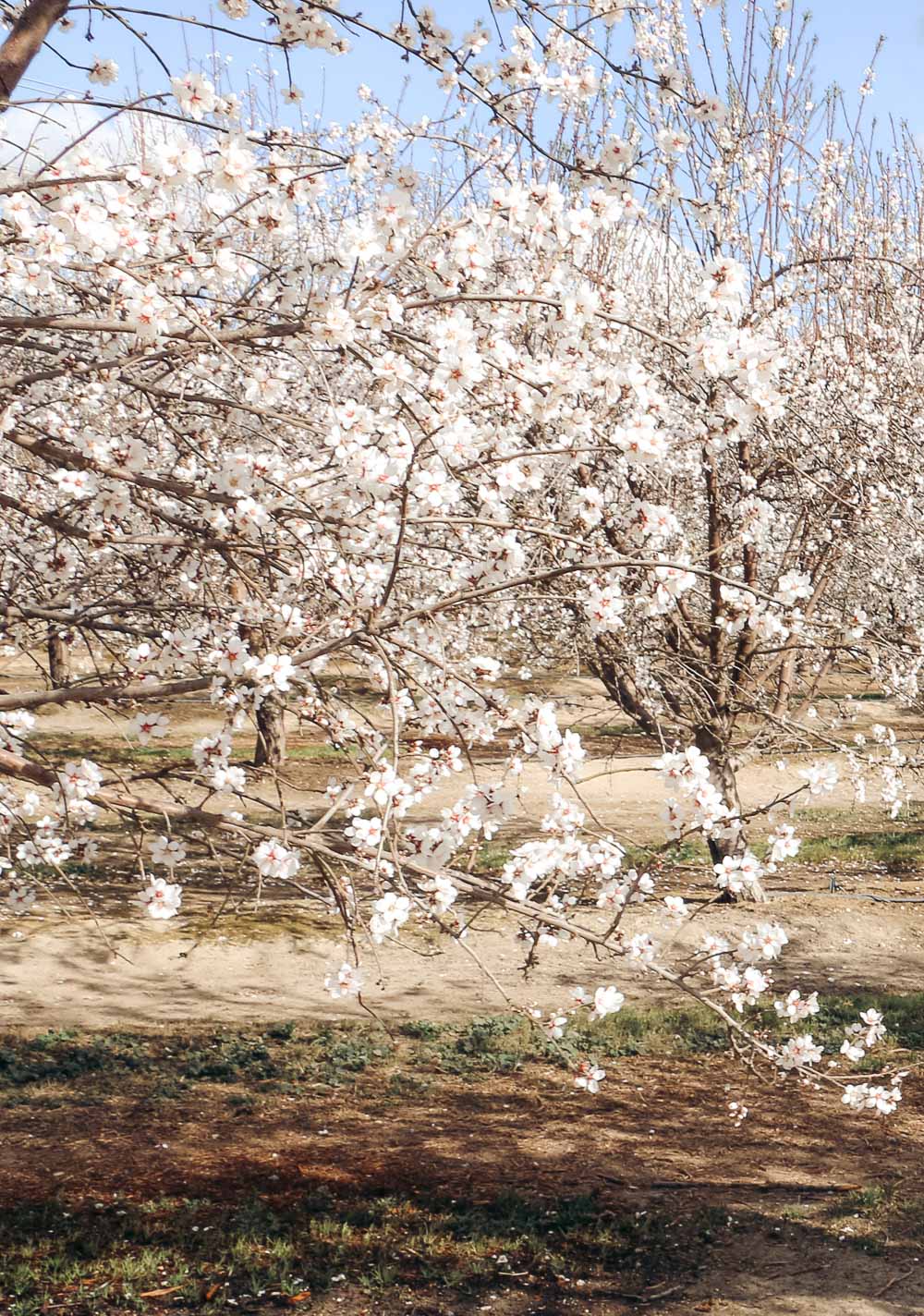
5. Blossoming Orchards in Davis, California
11 miles west of Sacramento sits another town that plays a vital role in the nut and fruit production in California. Davis, known as “Davisville” prior to 1907, was created as a farming community.
The city hasn’t changed its focus and still supplys the state and country with organic apples, nectarines, peaches, apricots, and figs to name a few. Apart from its supreme orchards and farms, the city entices with the United States Bicycling Hall of Fame that holds a large collection of antique bikes and trophies.
Where to Find Blooming Orchards in Davis, California
The area around Davis grows mostly fruits. Occasional visitors, however, often mistake the white-petaled trees for the almond orchards. Regardless of the kinds of the trees, these blooming plantations never fail to instill awe and ask to stop for a short photo session.
- The Collins Farm . The farm specializes in growing peaches, nectarines, apricots, figs, berries, and vegetables. ( Note: As of October 2023, the farm is closed)
- Black Bicycle Farm. Located on the outskirts of Davis, this family-owned farm and vineyard produces grapes, peaches, nectarines, apricots, apples, and plums. It’s also the right place to come back in summer to lay your eyes on lavender fields.
6. Blooming Orchards in Winters, California
Winters is a small city in rural Yolo County in Northern California. With the main focus on farming, it follows almost the same path as all other agricultural cities in the region.
The place originated in 1842 when a Kentucky immigrant, William Wolfskill, received a Mexican grant for Rancho Rio de los Putos. William’s brother, John Reid Wolfskill, also embarked on an agricultural endeavor by planting orchards and vineyards on his land in the Sacramento Valley. Several years after obtaining the property, William transferred half of this land to his brother. In 1854, he moved the rest of his property to John.
Yet the city owes its name to Theodor Winters rather than the Wolfskill brothers. Theodore’s ranch occupied half of the town. It only made sense that the place was named after the biggest landowner in the area.
Where to Find Blossoming Orchards in Winters, California
- K&J Orchards. Starting in 1980, the farm has produced nuts and fruits, such as walnuts, apples, apricots, cherries, citrus, figs, peaches, and plums. In late winter – early spring, it morphs into a colorful sea, brimming with gentle petals and sweet aroma.
- Sierra Orchards. Sierra Orchards is another place to enjoy enchanting blooming orchards in Northern California. The farm was established in 1980 and produces mostly organic walnuts and olive oil.
- Martinez Ranches . Martinez Ranches has adorned Northern California with acres of the blossoming almond and fruit orchards for more than 40 years. On top of the popular almonds, the company farms produce walnuts, pistachios, prunes, peaches, and apricots.
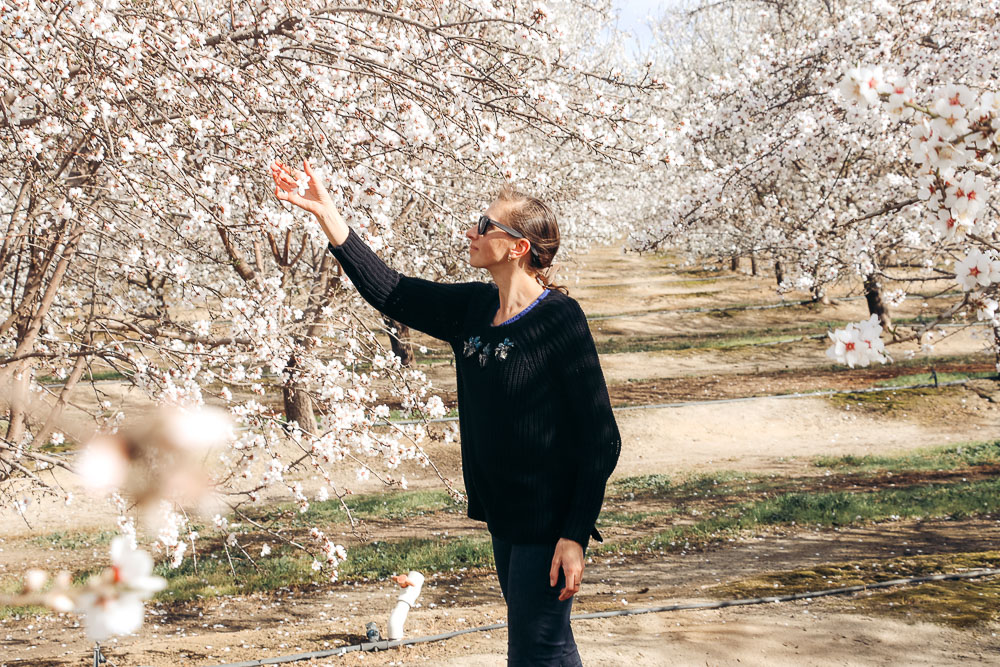
What to Know Before Visiting Blooming Almond Orchards in California
Respect private property.
The blossoming almond orchards allure more than a jar full of candies and chocolate pastries. You can hardly drive or bike past one of these large areas filled with the blooming trees without sneaking behind the wire fences to take a few pictures.
We did it, too. Truth be told, we were trespassing on farmer’s land just like the majority of the blooming orchards’ enthusiasts do every year. While some farmers don’t mind encountering a couple of the occasional violators on their lands, others frown at the thought of dealing with the influx of the unwelcoming guests.
Therefore, be respectful of the private property while visiting the blooming almond orchards in California. Don’t abuse farmer’s hospitality by destroying the trees and gathering large “bouquets” made of the blooming almond branches.
Leave as Quickly as Possible
The large plantations with the perfectly aligned trees blanketed with white veils are tempting. Go and photograph those stunning orchards if you need to, but be sure to get out as soon as you’re done . Remember again, it’s a private property. You wouldn’t want to have some uninvited guests having picnic in your backyard. The same applies for visiting California’s almond orchards.
Wear Waterproof Shoes
The ground under the trees can be muddy. I was perfectly fine wearing ballet flats during our quick visit to an almond orchard. Some people are less lucky and insist that you need to wear boots or waterproof shoes.
- California Super Bloom: Where to See Wildflowers near Los Angeles
If you found this post useful, don’t forget to pin it for later and share it with your friends.
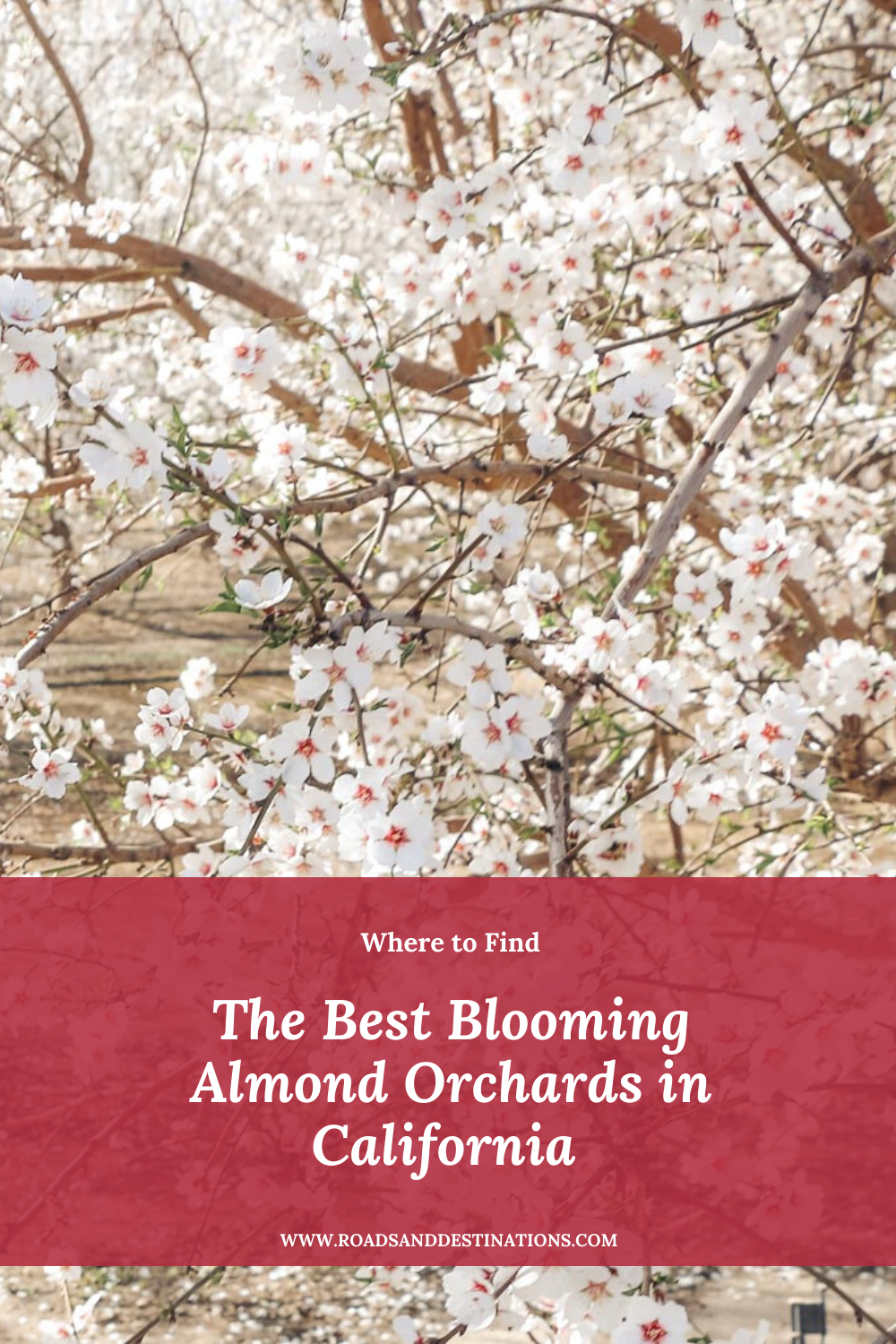
You may also enjoy:
8 iconic photo spots in glacier national park, visit bear lake, a crown jewel of rocky mountain national park, colorado, tundra communities trail in rocky mountain national park – a hike like no other, the 11 best things to do in yosemite with kids, leave a reply cancel reply.
Your email address will not be published. Required fields are marked *
This site uses Akismet to reduce spam. Learn how your comment data is processed .
Get in touch
Sign up for newsletter.
Join Roads and Destinations' mailing list and get new blog updates, upcoming events, and exclusive travel resourses.

Welcome to Valencia Travel Village RV Resort
A Premier RV Resort in a Beautiful Country Setting With Mature Trees and Grassy Sites.
Open Year Round
Close to los angeles attractions, such as six flags magic mountain, universal studios, hollywood, museums, beaches & disneyland-california adventure.
We have 381 RV sites which can handle big rigs. Guests can enjoy our 2 heated pools, spa, kiddie pool, and playground. We have a convenience store and laundry facilities for our guests. We are conveniently located near golf courses, churches, shopping and only 3 miles from Magic Mountain. Many Los Angeles attractions such as Six Flags Magic Mountain, Universal Studios, Hollywood, museums, beaches and Disneyland/California Adventures, are a short drive away. There are several lakes nearby for boating and fishing. The relaxed, friendly atmosphere and great location makes us ideal for any RV enthusiast to enjoy.
We are open year-round and strongly recommend reservations. We are located on Hwy. 126 West, just 1 mile west of Interstate 5 (I-5), 2 miles north of Magic Mountain Parkway.

ALDI - Santa Clarita, CA
Hours aldi - santa clarita, ca, holiday hours 2024 show.
Is this information correct?
Weekly Ad & Flyer ALDI

- Wed 09/11 - Tue 09/17/24

- ALDI Fall Seasonals

View more ALDI popular offers
Labor Day Opening hours
On Labor Day, though, most stores will close two hours earlier than usual, with operating hours from 8:30 a.m. to 6 p.m.
ALDI - Santa Clarita, CA - Hours & Store Details
ALDI is conveniently situated at 24860 Orchard Village Road, within the south part of Santa Clarita ( a few minutes walk from William S Hart High School ). Customers can easily come here from Elayon, Waltz and Newhall. Today (Monday), operation begins at 9:00 am and ends at 9:00 pm. Refer to this page for the specifics on ALDI Santa Clarita, CA, including the hours of business, location details, customer feedback and further pertinent information.
Getting Here - Orchard Village Road, Santa Clarita
ALDI can be found in an ideal space not far from the intersection of Avenida Balita and Orchard Village Road, in Santa Clarita, California.
Merely a 1 minute drive time from Avenida Rotella, Lyons Avenue, Apple Street and Valley Street; a 4 minute drive from Calgrove Boulevard, Exit 167 (Golden State Freeway) of I-5 and Railroad Avenue; and a 12 minute drive time from Golden State Freeway (I-5) or Pico Canyon Road.
Drivers that use route finder devices should enter the address 24860 Orchard Village Road, Santa Clarita, CA 91355 to get to this location.
Customers can travel by train to Newhall Station (4420 ft) and Santa Clarita Station (2.54 mi away). Your line: Antelope Valley.
In the nearby area you may discover Old Orchard Park, Newhall Library, H M Newhall Memorial Park, Placerita Junior High School, Peachland Avenue Elementary School, William S Hart High School, Old Orchard Elementary School, Veteran's Memorial Park and Newhall Elementary School.
ALDI Locations Nearby Santa Clarita, CA
ALDI runs 2 existing supermarkets in Santa Clarita, California.
View the full index of all ALDI grocery stores near Santa Clarita .
Other Stores
The ups store lyons ave, santa clarita, ca, domino's pizza newhall, ca, chase bank newhall, ca.
- Company Overview
- Management Team
- Company Milestones
- Store Design & Development
- Retail Formats
- Lodging Owners
- Management Companies
- Hospitality Brand Partners
- Our Suppliers
- Interactive Portfolio Map
- New Openings
- Our Culture
- Starting Your Journey
- Our Benefits
Get In Touch

Experts in Our Field
View Our Portfolio

Extensive Portfolio

Sector Adaptability

Multi Format Retail Solutions

Integrated Platform & Scale

Iconic Locations
Store design and development, innovative retail formats.

Vision Statement
We went into this business to make our customers and our lodging owner/manager partners happy, to satisfy their needs through quality store design and construction, innovative retail solutions and outstanding customer service. This is still our mission 15 years later...

The Travel Traders Advantage
We are the country's leading developer/operator of integrated retail solutions to the full service lodging industry. Our strategic foundations comprise sector adaptability in the upscale to luxury tiers, flexible retail formats and solutions, integrated platforms and scale, and an extensive database of metrics and KPIs to drive performance - all with a focus on exceeding stakeholder expectations.
Latest News and Events
Travel traders opens 2,200 square feet retail space at the iconic beverly hilton, beverly hills, travel traders awarded contract to redevelop 9,500 square feet of retail space at the gaylord palms resort & convention center, orlando fl, travel traders expands in the houston market after acquiring the retail store at the 1,200 room hilton americas – houston, connected to the george r. brown convention center, new sheraton brand concept stores openings, travel traders takes over ex-disney stores in orlando, travel traders opens two retail locations in its first ski-in/ski-out resort at lake tahoe, travel traders to redevelop and operate its first retail location with ritz-carlton – a 700 square feet retail space at the ritz-carlton, marina del rey – opening summer 2022., travel traders opens 1,800 square feet of retail space at the 1,600 room hilton anatole in dallas, tx.

IMAGES
COMMENTS
Open today 10:00 AM to 9:00 PM. Stern's Travel Shop offers a selection of fine luggage with many shapes and sizes to choose from. A great place for the discerning traveler, the store stocks leather briefcases, shave kits and organizers, business travel accessories, clocks, and a wide array of other travel-related items. 408-497-0325.
Travel Store. Luggage Storage. Recommended Reviews. Your trust is our top concern, so businesses can't pay to alter or remove their reviews. Learn more about reviews. Username. Location. 0. 0. Choose a star rating on a scale of 1 to 5. 1 star rating. Not good. 2 star rating. Could've been better. 3 star rating. OK. 4 star rating. Good.
Tumi 10:00 AM to 9:00 PM. See all deals & offers. * Offers are only valid at Westfield Old Orchard. Offers may be subject to additional terms and conditions to those specified. See retailer for full terms and conditions. 4905 Old Orchard Center (Skokie Blvd. & Old Orchard Rd.) Skokie IL 60077. 847.673.6800. 10:00 AM to 9:00 PM.
Specialties: Customer centric luggage retail store where customer service is our priority. We make travel easy by matching right products for customers needs and requirements. Interaction with us goes long way beyond your travel needs.
2855 Stevens Creek Blvd. TUMI Store Valley Fair. Open Now - Closes at 8:00PM. 2855 Stevens Creek Blvd. Suite 1043. Santa Clara, CA, 95050. 669-312-0044. Get Directions. Find Another TUMI Store.
Andy's Orchard is a family-owned farm in the Santa Clara Valley that offers premium stone fruit, dried fruits, nuts, and confections. Visit their online store or their country store from May to December to shop for delicious and handmade products.
Andy's Orchard is a fourth-generation orchard that grows cherries, apricots, peaches, nectarines, and plums. It is known for its quality, innovation, and rare and specialty varieties of stone fruits.
Top 10 Best Orchard in Santa Clara, CA - September 2024 - Yelp - Kaiser Santa Clara Farmers' Market, Tsukuda Fruit Stand, Yamagami's Garden Center, The Tortoise Home Campbell, Evergreen Farm, Cupertino McClellan Ranch Preserve, Greenhearts Family Farm, Sunnyvale Farmers' Market, SummerWinds Nursery - Campbell, The Forge Garden.
Casa de Fruta is a landmark orchard resort in California that offers farm-fresh produce, nuts, dried fruits, gourmet gifts, and more. You can also stay in cozy cabins, taste local wines, ride the Casa de Choo Choo train, and enjoy the vintage carousel and miner's sluice.
Bags N All is a one-stop travel gear destination located in Kelowna BC, with a great selection and the lowest prices on luggage, handbags, backpacks, travel accessories and more. Welcome to our store, where we help you prepare to travel the world!
TravelStore is a worldwide travel partner that offers customized solutions and personalized service for your business and leisure needs. Whether you want to explore new destinations, enjoy exclusive deals, or get insider tips, TravelStore can help you plan your unforgettable trip.
Caltrain operates a train from Sunnyvale Caltrain Southbound to Santa Clara Caltrain Southbound hourly. Tickets cost $3-5 and the journey takes 14 min. Alternatively, Santa Clara VTA operates a bus from El Camino & Sunnyvale-Saratoga to El Camino & McCormick every 10 minutes. Tickets cost $1-5 and the journey takes 20 min.
OSH is a local hardware and gardening store with neighborhood locations in the Bay Area and Central Coast. Find grills, fire pits, patio heaters, plants, tools, paint and more at OSH.
The Promenade Shops at Orchard Valley. Phone: (901) 531-8710. ... helping you find the most convenient outlet shopping based on your location and travel plans. OutletBound has all the information you need about outlet malls near Santa Clara, including mall details, stores, deals, sales, offers, events, location, directions and more. There's ...
The fruit is sold at DeMartini Orchard store across the street. Address: 1 N. San Antonio Road, Los Altos. Saratoga Heritage Orchard: The Saratoga Heritage Orchard is run by the city, maintained by Orchard Keepers and historically preserved. The apricots are not sold, but Saratoga residents can come to Community Harvest Days or volunteer to ...
Valley of Heart's Delight. W hen I was growing up, Santa Clara County was still the foremost fruit-producing county in California with the romantic and well-deserved title, the "Valley of Heart's Delight". As children, we took for granted being able to wander among the great orchards in the spring, with their wealth of white and pink blossoms, and in the summer, when tree branches bent ...
4. Almond Orchards in Escalon, California. The Central Valley provides California with a myriad of places to feast your eyes on the blossoming almond orchards. After Fresno, Escalon, a city with less than 10,000 residents, amazes with its blooming fruit and nut trees at the beginning of the spring season.
Orchard Supply Hardware at 2340 Athens Avenue, Redding, CA 96001: store location, business hours, driving direction, map, phone number and other services. Shopping; Banks; Outlets; ... Hair Salons Home & Garden Insurance & Finance Other Services Outlets Pets Printing Real Estate Shoes Shopping Sports Toys & Gifts Travel & Lodging.
A premier RV resort in a beautiful country setting with mature trees and grassy sites. Close to Los Angeles attractions, such as Six Flags Magic Mountain, Universal Studios, Hollywood, museums, beaches and Disneyland-California Adventure.
ALDI is conveniently situated at 24860 Orchard Village Road, within the south part of Santa Clarita (a few minutes walk from William S Hart High School). Customers can easily come here from Elayon, Waltz and Newhall. Today (Tuesday), operation begins at 9:00 am and ends at 9:00 pm. Refer to this page for the specifics on ALDI Santa Clarita, CA ...
Travel Traders is a leading developer and operator of integrated retail solutions for full service hotels and resorts. It offers quality store design and construction, innovative retail formats and customer service, and operates in various locations across the US.
Visit the TUMI OUTLET Store at 4999 Old Orchard Center in Skokie, IL to shop the high quality luggage, bags and travel accessories. Skip to main content Skip to footer content. Just In: ... TUMI Store Old Orchard. Closed - Opens at 11:00AM . 4999 Old Orchard Center. Space B27. Skokie, IL, 60077. 847-675-2467. Get Directions Find Another TUMI ...
Find the store location, business hours, phone number and other services of Orchard Supply Hardware at 1950 S Broadway, Santa Maria, CA 93454. Orchard Supply Hardware is a retailer of hardware, home improvement and outdoor supplies.